Below the only known photograph of "Billy the Kid".
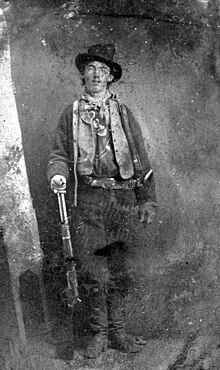
He wasn't "William H. Boney" as the tales tell us, but was born Henry McCarty on September 17, 1859, or was that November 23, 1859? Like his name his date of birth changes, but the date of his death, July 14, 1881 doesn't.
Although he was associated with the Lincoln County, New Mexico Wars. He had been born on Manhattan Island in the state of New York. After the death of her husband his mother Catherine McCarty moved her family to Indianapolis, Indiana. There she met and married Henry Harrison Antrim. The family next moved to Wichita, Kansas, in 1870. A few years later the family moved to Santa Fe, New Mexico. Catherine McCarthy died of tuberculous September 16, 1974.
Above Catherine McCarty Atrim. Below Henry Harrison Atrim.
At the age of 14, or was that 15, he was orphaned and found work at a boarding house in exchange for his room and food. On September 16, 1875, at the age of 16, Henry was arrested for stealing food and released. Ten days afterward he was arrested once again for robbing a Chinese laundry. Two days later he escaped and fled into the Arizona Territory The young man was now an Outlaw and Federal Fugitive.
In August 1877 the Outlaw reversed directions, after murdering a blacksmith, and fled the Arizona Territory back into the New Mexico Territory. Sometime during that year Henry McCarty became William H. Bonney.
"Booney" went to work for Englishman John Henry Tunstall, a business man and rancher, who partnered with lawyer and rancher Alexander McSween. Their main rivals were ranchers Lawrence Murphy and his partner James Joseph "John" Dolan. Neither liked the idea that Tunstall and McSween were backed by the powerful New Mexico rancher and land owner John Chisum, Along with McSween organizing local small ranchers into a group for their own protection known as "The Lincoln County Regulators", or just "The Regulators". The group was in direct opposition to Murphy and Dolan's crooked land grabs through the office of Sheriff William J, Brady..
All the motion pictures that depict John Tunstall. Show him as an older father figure for the 18 year old Bonney. Problem was that Tunstall was only 24 years old and no way could he be that older father figure of the movies.

Above John Tunstall and below Alexander McSween

All of the friction between Tunstall, McSween, Murphy and Dolan came to a head in what became known as the "Lincoln County War". On February 18, 1878 Tunstall was murdered by men, working for Lawrence Murphy and John Dolan. They had been disguised as a posse led by Sheriff Brady. John Tunstall was shot in the chest by one member of the "legal" posse and in the back of the head by another.
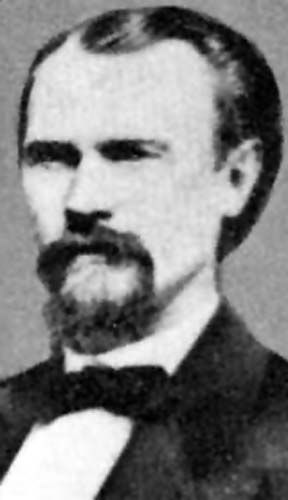
Above Lawrence Murphy and below James Joseph "John" Dolan
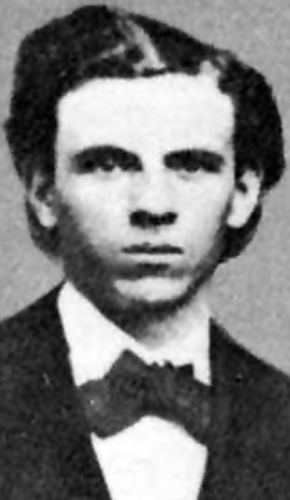

Above Sheriff William J. Brady and below John Chisum

As a result of the murder of John Tunstall. Billy Bonney and other young ranch hands, all part of "The Regulators", sought revenge on Murphy, Dolan and Sheriff Brady. The facts of the actual war can be found on line for those interested.
On August 5, 1878 the war was over and four of the survivors, including "Billy the Kid", were charged with the murder of Morris Bernstein a bookkeeper for the Mescalero Indian Agency. Even though there was evidence that the murder had been committed by Federal Constable Alancio Martinez. Three of the four's indictments were quashed, but not Bonney's.
On February 18, 1879 Bonney and his friend Tom O'Folliard were in the town of Lincoln and witnessed the murder of attorney Huston Chapman. Chapman was shot and killed by Jesse Evans and his body set on fire. Billy wrote a letter to New Mexico governor Lew Wallace that in exchange for amnesty he would testify against Evans.
Governor Lew Wallace was an ex-Northern General and author of the novel "Ben Hur". Wallace responded to Boney suggesting he be arrested for his own protection until his testimony was required. On March 21, 1879 Boney let himself be captured by Sheriff George Kimball. However, after taking his testimony the local District Attorney refused to free him. Several weeks passed and "The Kid" started to believe he had been tricked by Wallace and on June 17, 1879 he escaped.
Bonney stayed away from any violent action until January 10, 1880 when he shot Joe Grant in Old Fort Sumner, New Mexico.
On December 13, 1880 Wallace created a $500 reward for William H. Bonney's capture. Sheriff Pat Garrett, below, was one of those "Bounty Hunters" after "The Kid" and the money

How William H. Bonney died is still debated today. The events in that death vary with the source including Pat Garrett's own book, but what is described as the "Canonical Version" goes like this.
Pat Garrett went to the house of Pete Maxwell, the son of a New Mexico Land Baron, and asked about Bonney. The two men were sitting in a darkened room still talking when the Outlaw entered. According to the tale William H. Bonney asked in Spanish twice:
Who Is It?Pat Garrett recognized his friends voice and drew his revolver firing two shots. One hit "Billy" in the chest just over his heart killing him. A few hours later a Coroner's Jury of six men were assembled and they reviewed the room the killing occurred in and the body. The Jury Foreman stated in a local newspaper:
It was the kid's body we examined.The acting Governor of New Mexico refused to give Pat Garrett the reward, because of other versions of the killing that was now circulating stating Garrett ambushed his friend. As I said Pat Garrett would write his own version of the life of the kid and his death. The book changed Garrett from a one time Outlaw, Bounty Hunter and Sheriff into a respectable man. Who was forced to track down his friend. Different groups would raise $7,000 to give to Pat Garrett for killing "The Kid".
There was a popular song going to the myth of "Billy the Kid". The lyrics stated he had 21 notches on his gun and Sheriff Pat Garrett would be 22. However, there are only 8 known murders by William, H. Bonney.


The Governor of Texas in 1950, Thomas Mabry, rejected "Bushy Bill's" claim, but the "Billy the Kid Museum" in Hico, Texas, his home town, claims he was "The Kid".
Many of the Hollywood motion pictures about "Billy the Kid" show Reward Posters in Sheriff Offices, or in the hands of Bounty Hunters. There never was any of those type of reward posters for William Bonney. However, "Pat Garrick" did place a reward notice, authorized on December 13, 1880, by Governor Wallace,in two New Mexico newspapers:the "Las Vegas Gazette" and later in the "Santa Fe New Mexican".
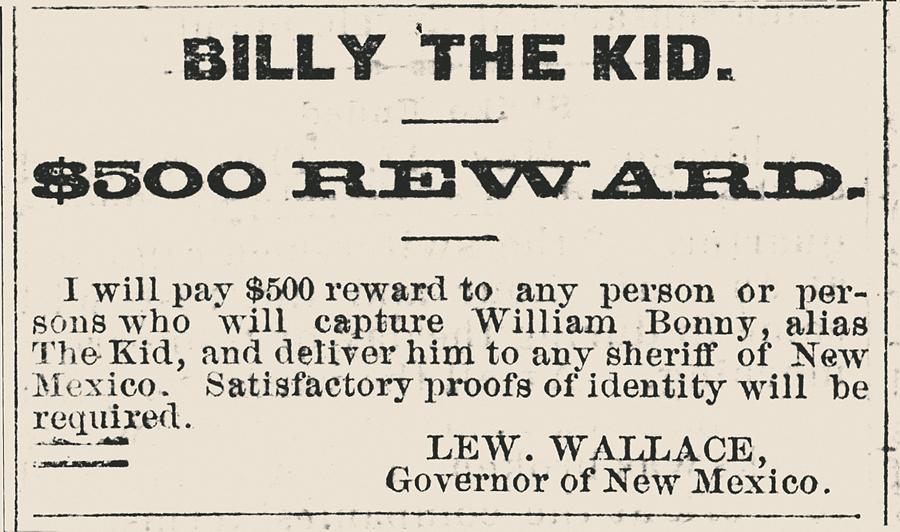
BILLY THE KID: Hollywood Style
The first motion picture was a silent and ran one reel.
BILLY THE KID released August 9, 1911
The screenplay by Edward J Montagne really did a number on the films title character and had nothing to do with the real life events. In fact HE was played by "Actress" Edith Storey. One has to wonder, if William H. Bonney was really still alive and what he thought of the film, if he saw it?

In an article from "The Moving Picture World" entitled "When Billy the Kid was Billie the Kid". We find the only review of this lost film. Edith Storey was known for playing young male roles.
"The duties of the sheriff as performed by "Uncle Billy" were not a matter of pleasure. His son-in-law is a member of the posse; lie and "Uncle Billy" leave the house hurriedly to join their comrades in pursuit of the outlaws. Two hours later the son in-law is carried back to his home, the victim of the gang. A little daughter is born to the widow and left an orphan. "Uncle Billy" is anxious that the child should be a boy, but through the secrecy of the Spanish servant. "Uncle Billy" never knew that "Billy, the Kid." was a girl. The sheriff brought her up as a young cowboy, although he noticed there was a certain timidity in the "Kid" that was not at all becoming a boy. When "Billy, the Kid," is sixteen years of age, her grandfather sends her to a town school. Lee Curtis, the foreman of "Uncle Billy's" ranch, was the "Kid's" pal; they were very fond of each other, and it was hard for Lee to part with his young associate, when he accompanied her to the cross roads where they meet the stage. The stage is held up by the outlaws. The "Kid" is taken captive and held as a ransom; they send a note to "Uncle Billy" saying: "If he will grant them immunity, they will restore the 'Kid.'" When the sheriff gets this message, he is furious, and the Spanish servant who well knows that the "Kid" is a girl, is almost frantic with apprehension lest the "Kid's" captors discover this fact. She tells "Uncle Billy" why she has kept him in ignorance of the truth. Lee Curtis overhears the servant's statement, and with the sheriff, rushes out to get the posse in action. "Billy the Kid" has managed to escape from the outlaws and meets the sheriff and his posse. Her grandfather loses no time in getting her back home and into female attire. This time "Uncle Billy" Is going to send the "Kid" to a female seminary and he is going to take her there himself. She tells her grandfather she just wants to be "Billy the Kid" and have Lee for her life companion. "Uncle Billy" has nothing more to say, and it is not long before she changes her name to Mrs. Lee Curtis."
The next feature film was 19 years later.
BILLY THE KID released October 18, 1930
The cinematic legend of "Billy the Kid" was first brought to the motion picture screen by director King Vidor. Vidor had directed the hard hitting and realistic war movie 1925's "The Big Parade". In 1946 he directed the very sexual Western "Duel in the Sun' starring Gregory Peck and Jennifer Jones and in 1956 there was the big budget epic version of Leo Tolstoy's "War and Peace". It featured a terribly miscast Henry Fonda. King Vidor was also the co-producer of this movie with Irving Thalberg. As Universal Pictures "Wonder Kid" Thalberg was the man behind Lon Chaney, Sr.
From a technical point of view "Billy the Kid" was in an early MGM 70 mm wide screen process called "Realife". However, this production was overshadowed by another early 70 mm motion picture from Fox Films. That process was called "Grandeur" and the film "The Big Trail" was also the first movie with the name of John Wayne on the marquee. My article on both that motion picture and that film process can be read at:
http://www.bewaretheblog.com/2015/10/john-wayne-william-fox-grandeur-and-big.html
The screenplay for this 1930 motion picture was based upon a 1926 novel "The Saga of Billy the Kid" by Walter Noble Burns. The writing credits were created piecemeal by seven writers for what became the screenplay. Wanda Turlock did what was called continuity. Working on the flow of the film. She only had 3 previous writing credits. Laurence Stallings worked on the dialogue. He had 10 previous films and 6 were silent. Then there was Charles MacArthur a newspaper writer and playwright. His on screen credited job was additional dialogue. Along with four others who assisted without on screen credit.
"Billy the Kid" was portrayed by John Mack Brown an ex-Alabama College Football Star. As Johnny Mack Brown he would become a major "B" Cowboy Star and between 1933 and 1953 appear in 127 Westerns.
King Vidor didn't want him for the role, but was told to use him.

"Pat Garrett" was portrayed by Wallace Beery. Beery had been "Richard the Lion Hearted" in Douglas Fairbanks, Sr. 1922 "Robin Hood". He was "Professor George Edward Challenger" in stop motion animator Willis O'Brien's classic 1925 version of Sir Arthur Conan Doyle's "The Lost World". In 1934 he would be "Pancho Villa" in "Viva Villa!", "Long John Silver" in "Treasure Island" and "P.T. Barnum" in "The Mighty Barnun".

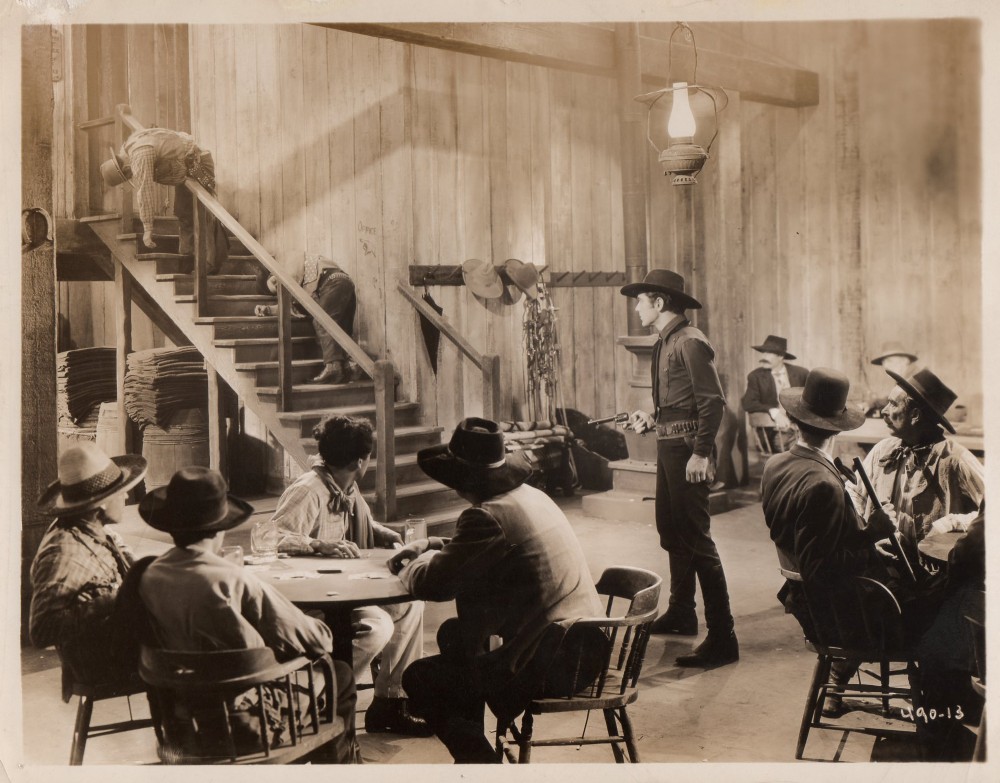
The screenplay had two endings with one for North America and one for Europe. In the United States the picture ends with Pat Garrett letting Billy ride off into the Western Sunset of Legend. While the European version has Pat Garrett kill "The Kid".
He would be called "The King of the Cowboys", but in 1936 Roy Rodgers was "Billy the Kid" and his double.
BILLY THE KID RETURNS released September 4, 1938

Roy Rodgers portrays both "Billy the Kid" and "Deputy Sheriff Roy Rodgers". Leonard Franklin Slye, co-founder and lead singer of what became the "Sons of the Pioneers", had his name changed to Roy Rodgers in 1938, When Gene Autry demanded more money and Herbert Yates the owner of Republic Picture said good-bye. By this feature Slye/Rodgers had already appeared in 15 motion pictures as a singing cowboy.
In this "Billy the Kid" western he would sing 5 songs.
Roy's co-star was comedian/musician Lester Alvin Burnette billed always as "Smiley Burnette". Burnette was in the role of "Frog Milhouse". He was known to play 100 instruments and could move from one to another with ease while playing a single piece of music. As a composer his songs would total 400 and have been recorded by Willie Nelson, Bing Crosby, Ferlin Husky and the Riders in the Sky among others.
Billed for this picture as Mary Hart was "B" actress Lynne Roberts portraying "Ellen Moore".
The role of "Pat Garrett" was portrayed by Wade Boteler. At the end of his career Boteler had appeared in 430 motion pictures between 1919 and 1943.
Following the shooting of "Billy the Kid" by his former friend "Pat Garrett". Deputy Sheriff Roy Rodgers, who is the double for "The Kid", and his sidekick "Frog". Go down to Lincoln Country, New Mexico, and help the good ranchers win over the evil ranchers. All in typical 53 minute "B" Western style. Rodgers also wins this girl in this pre-Dale Evans entry.
BILLY THE KID OUTLAWED released July 20, 1940
This was the first of 19 "B" motion pictures from a "Poverty Row Studio:, meaning located on Gower Street in Hollywood and made as a very low budget, "Producers Releasing Corporation".

Already a "B" Western Star Bob Steele had appeared, or starred in 91 Westerns to date. In "Billy the Kid Outlawed" he portrayed the title character of "Bill Bonney aka Billy the Kid" for the first time.

Above left to right: Keene Duncan as "Dave Henricks", Louise Curray as "Molly Fitzgerald" and Bob Steele as "Bill Bonney".
Portraying the comic side kick "Fuzzy Jones" was Al "Fuzzy" St. John. St. John became a regular side kick for Buster Crabbe, Lash La Rue and other "B" Cowboys for a total of 337 motion pictures.

Above Steve Clark was "Shorty Rice", Carleton Young was "Billy's" other friend "Jeff Travis".
The plot of this 52 minute action packed Western takes place in Lincoln County, New Mexico. We first meet "Billy", "Fuzzy" and "Jeff" driving cattle for the "Bennett" brothers. When a stagecoach carrying "Judge Fitzgerald" and his daughter "Molly" is attacked by the men working for the two villains "Pete Morgan", Joe McGuinn, and "Sam Daly", Ted Adams.
"Sheriff Long" deputizes "Billy", "Fuzzy" and "Jeff" to get "Morgan" and "Daly's" gang and bring in the two leaders for trial. However, the Sheriff is voted out of office and "Daly" takes his place. He brands the three friends Outlaws and issued rewards for their capture.
In the end the crooks are brought to justice, but "Billy", who doesn't believe in the pardon offer of the Governor, with "Fuzzy" and "Jeff" ride off into the sunset to meet their fates.
On September 30, 1940 Bob Steele was back in "Billy the Kid in Texas". Like Lash Larue, Bob Steele now wore a "Black Hat", normally associated as a "B" Western bad guy, but like the other Cowboy actor was now an anti-hero.
"Bonney" arrives in a wide open Texas Town and meets his old friend "Fuzzy Jones", Al St. John. "Billy" confronts and chases off the town thug "Flash", portrayed by John Merton, and is made "Sheriff". "Billy' now goes after "Flash" and his gang. One of the members is "Gil Cooper".portrayed by the returning Carlton Young. What nobody knows is that he's actually "Billy's" brother "Gil Bonney". The real "Bonney" had a brother named Joseph McCarty who never went west.
In this second entry "Gil" is reformed and helps his brother. "Flash's" gang is captured and stolen money recovered. At the end 52 minutes later, Gil" remains behind with"Mary", portrayed by Terry Walker, and "Billy" and "Fuzzy" ride off once more into the sunset.
Bob Steel would continue as "Billy the Kid", good guy, in four more films. These were:
"Billy the Kid's Gun Justice" released December 17, 1940.
"Billy the Kid's Range War" released January 24, 1941.
"Billy the Kid's Fighting Pals" released April 18, 1941
"Billy the Kid in Santa Fe" released July 11, 1941.
In all those features Al St.John was back as "Fuzzy Jones" and Charlton Young was in every one, but playing different roles.
For the next 13 films in the series Bob Steele was replaced by "Flash Gordon" and "Buck Rodgers" and one time "Tarzan" Buster Crabbe. I could not locate the reason for Steele being replaced by Crabbe, but his career went down hill and he became mostly a Western character actor. Al "Fuzzy: St.John was back for these additional films.
The first feature with Buster Crabbe was "Billy the Kid Wanted" released October 4, 1941.

Below Glenn Strange, before he became the "Frankenstein Monster" in three Universal Studio movies, St. John and Slim Whitaker as the "Second Sheriff".

"Billy the Kid's Round-Up" released December 12, 1941 continued the formula that fans of these films wanted to see.


Above Charlton Young was back as "Jeff", Crabbe wore a "Grey Hat" and Al "Fuzzy" St/John brought the laughs. When Young wasn't "Jeff" the character was portrayed by David O'Brien seen below between Crabbe and St. John, from 1942's "Law and Order".

The rest of the series were:
"Billy the Kid Trapped" released February 12, 1942.
"Billy the Kid's Smoking Gun" released May 1, 1942.
"Law and Order" released August 21, 1942
"Sheriff of Sage Valley" released September 2, 1942
"The Mysterious Rider" released November 20, 1942.
"The Kid Rides Again" released January 27, 1943
"Fugitive of the Plains" released April 1, 1943
"Western Cyclone" released May 14, 1943
"Cattle Stampede" released August 16, 1943
"The Renegade" released August 25, 1943
The final film in the "Billy the Kid" as a good-bad guy series was:
"Blazing Frontier" released September 4, 1943.

For some reason there would be another 23 motion pictures made starting with "Devil Riders", released November 5, 1943, but Buster Crabbe was no longer called "Billy the Kid". His new characters name was "Bill Carson" and Al St. John was now "Fuzzy Q. Jones". Otherwise there was no difference between Crabbe and St. John's previous films together and these.
HOWEVER, the change by "Producers Releasing Corporation" was probably attributed to Republic Pictures now calling Roy Rodgers "The King of the Cowboys", because Buster Crabbe was now billed as:
BUSTER CRABBE "KING OF THE WILD WEST"
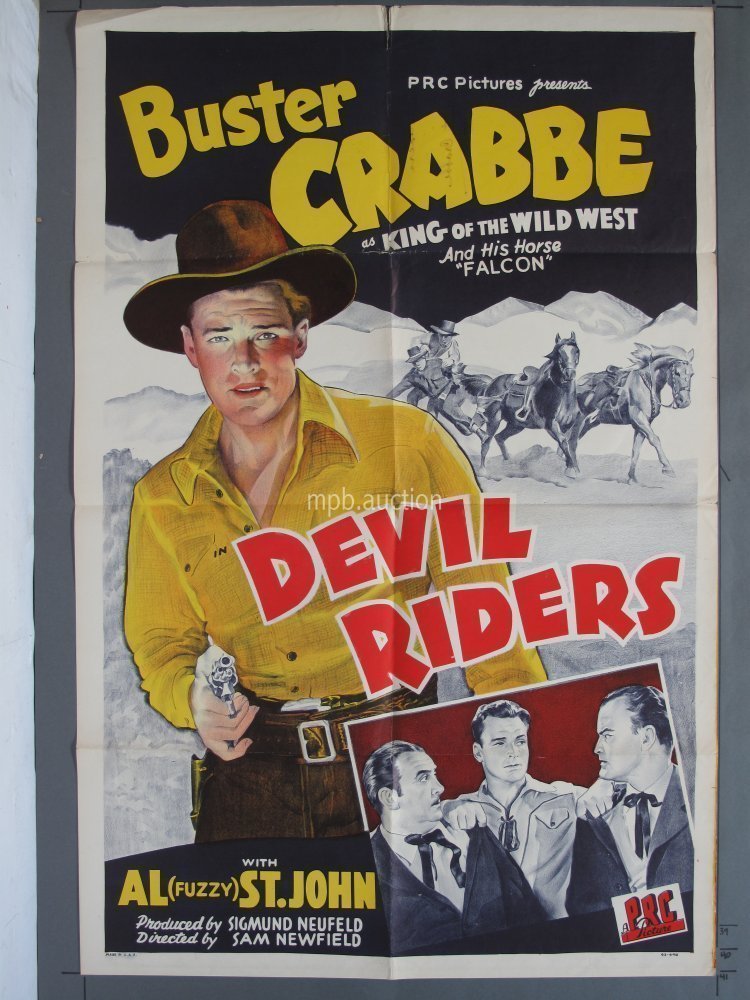
Just prior to Bob Steele's last ride as "Billy the Kid". Metro-Goldwyn-Mayer decided to remake their 1930 motion picture.
BILLY THE KID released May 30, 1941

The source material for this motion picture was the same novel by Walter Nobel Burns. The screenplay was by Gene Fowler. Fowler had written 1932's "What Price Hollywood" that many thought was copied as the original 1937 "A Star is Born". Fowler had also written 1934's "The Mighty Barnum" and 1935's "Call of the Wild". The original story was credited to two writers. They were Bradbury Foote who had written the screenplays for 1940's "Young Tom Edison" and "Edison the Man". The other writer was Howard Emmett Rodgers who worked on "B" pictures, but no major productions until this film.
The director was David Miller who directed 24 short subjects for MGM prior to this feature film.
Then there was Robert Taylor as "Billy the Kid". Although he had been acting on screen since 1934. "Billy the Kid" was really his first non handsome "Formula" leading man role. This somewhat edgy character changed Taylor's direction and led to him becoming an audience favorite. Appearing in pictures such as 1941's "Johnny Eager" portraying a gangster and 1943's "Bataan". A patriotic World War 2 film ending with Robert Taylor, the last man alive in his company, shooting a machine at the audience as he is overrun by the Japanese.

There is no "Pat Garrett" in this picture and Brian Donlevy portrays "Billy's" friend "Jim Sherwood".
Donlevy was a strong supporting actor and was cast in many films as the bad guy. He had the colorful name of "Knuckles Mulberry" in 1935's "Barbary Coast" starring Miriam Hopkins and Edward G. Robinson, he co-starred with Claire Trevor in 1936's "Human Cargo" as "Packy Campbell", he was the villainous "Sergeant Markoff" in 1939's "Beau Geste" starring Gary Cooper, Ray Milland and Robert Preston and the Carpetbagger working for the railroad in the same years "Jesse James" starring Tyrone Power, the actor the critics kept comparing Taylor too, and Henry Fonda.
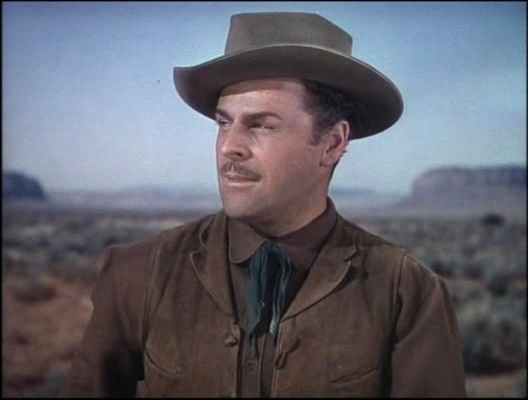
This motion picture plays off of the story that "Billy the Kid" was Left Handed. Actually it was discovered that the only known photo of him, see above, shows "The Kid" holding a Winchester Rifle in his RIGHT hand and his Pistol strapped to his body on his LEFT side. However, it was finally discovered that when the photo was printed. It was backwards and "Billy the Kid" is actually RIGHT HANDED.
The very fictional screenplay opens in 1880 and "Billy the Kid" is already a "Famous Gunslinger". He helps his friend "Pedro Gonzales", Frank Puglia, escape jail from mean "Sheriff Cass McAndrews", portrayed by Cy Kendall,

The two go back to the saloon that refused to sell a drink to a Mexican and there meet Rancher "Dan Hickey", Gene Lockart, the "Murphy role", 1940 biwho hires them. He wants to scare some of the local farmers into joining "Hickey" against "Eric Keating", Ian Hunter, another rancher.
"Billy" and others to work up the farmers stampede cattle onto farm land and a farmer is killed. "Billy" is bothered by this and during the stampede he meets a childhood friend "Jim Sherwood". "Sherwood" talks "Billy" into going to work for "Eric Keating".
Enter a love story as "Billy" meets "Keating's Sister Edith", Mary Howard. "Billy" falls for "Edith" and the audience has a secondary story.

"Eric Kearing" leaves to go to the Governor over the violence being caused by "Hickey". "Eric" doesn't return and has been killed. "Pedro" is shot in the back by one of "Hickey's" men and the Lincoln Country War begins.
After talking to "Hickey" it appears "Sherwood" has switched sides. He tells the Sheriff to lock "Billy" up for his protection. "Hickey" attempts to get the honest Sheriff to kill "Billy" and say he was shot while escaping. "Billy" does escape, but thinking the Sheriff wanted to kill him. He kills the Sheriff and this turns "Jim" against him.
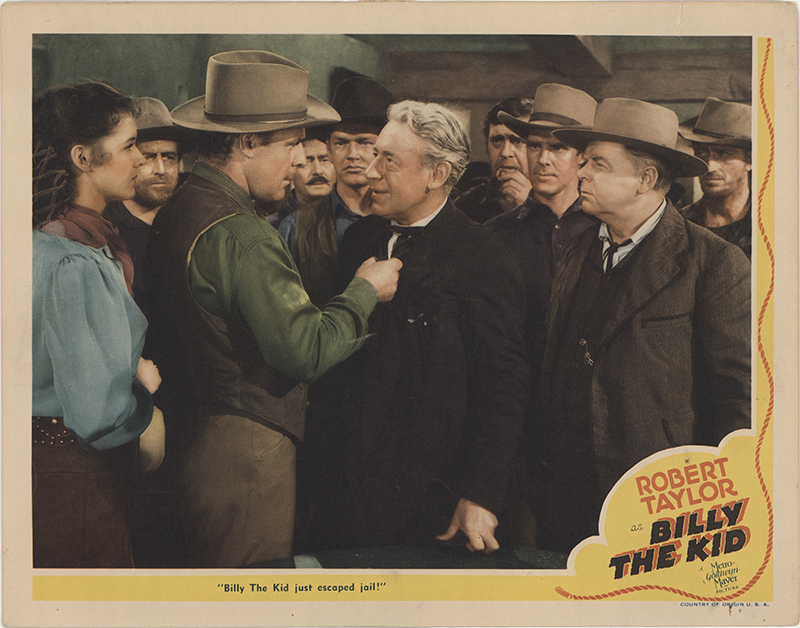
"Billy" and another of "Keating's" cowhands, "Tim Ward", Henry O'Neil, track down and kill each of the men responsible for his death. Then it's time for the showdown between "Billy" and "Hickey". "Jim" tries to convince "Billy" not to shoot "Hickey" and let him arrest the rancher. However, "Hickey" attempts to run away and "The Kid" kills him.
"Billy" now challenges "Jim", but he deliberately uses his right hand and not his left. As a result "Jim" is able to kill "Billy" and afterwards realizing what "The Kid" had done.
THE OUTLAW released February 5, 1943
This is the Howard Hughes version of "Billy the Kid" shot and completed in 1941. It was kept out of theaters by the "Hays Censorship Office" until 1943. It was then released for one week and had to be pulled, because it still violated the "Motion Picture Production Code" for certain scenes with Jane Russell.
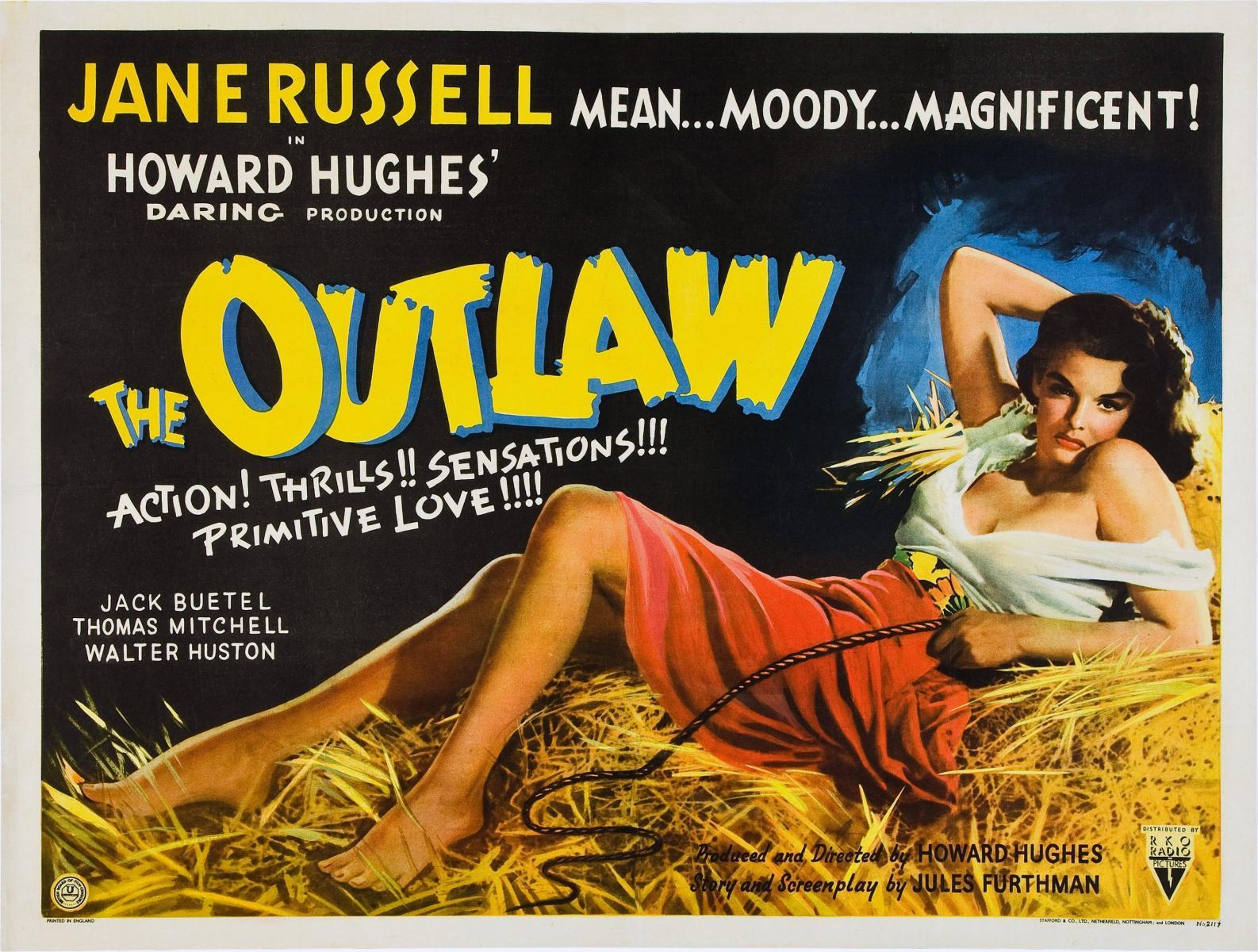
This is also the legendary Western that Hughes felt Russell's bust size was too small and had his "Trans World Airlines (TWA)" design a better bra. According to Russell the bra hurt and she just stuffed her regular one with toilet paper. Either way the "Hayes Office" objected.
The motion picture was produced by Howard Hughes and his name appears as director. However, it is generally recognized that most of the shoot was by the non screen credited director Howard Hawks. Who had directed the 1933 original "Scarface", the 1938 screwball comedy "Bringing Up Baby" with Cary Grant and Katharine Hepburn and 1941's "Sergeant York" with Gary Cooper at this point.
The screenplay was by Jules Furthman. Furthman started writing screenplays in 1915 and in 1920 wrote "Treasure Island" that featured Lon Chaney as as "Blind Pete". He followed "The Outlaw" with two screen plays for Howard Hawks starring Humphrey Bogart. They were 1944's "To Have and Have Not" and 1946's "The Big Sleep". In 1959 Furthman co-wrote the screenplay with Leigh Brackett for Hawks' "Rio Bravo".
The four leads were:
Jack Buetel as "Billy the Kid". This was his first motion picture and his next wouldn't be until 1951. When he played "Cole Younger" in "Best of the Badman" starring Robert Ryan. The problem was Buetel was under contract to Howard Hughes and he refused to permit the actor to work and damage his image as "Billy the Kid", or so the story goes.. Howard Hawks had wanted Jack Buetel for the role of "Matt Garth" in "Red River" and had to give the role to Montgomery Clift, because Hughes would not release Buetel even to him.

Jane Russell was "Rio McDonald". This was Russell's first film also, but she didn't have the problems with Hughes that Beutel had. Her next film is completely forgotten and was 1946's "The Young Widow". However, her third film not only showed she could act, but that she was also a comedian. Her role was that of "Calamity Jane" in the 1948 Bob Hope comedy "The Paleface".

Thomas Mitchell was "Pat Garrett". Earlier in 1943 he had been seen co-starring with Henry Fonda and Maureen O'Hara in the war drama the "Immortal Sergeant" and later in 1943 Mitchell was on screen in another war movie with Robert Taylor "Baatan". Not to ever forget 1939's "Gone with the Wind", or that same years "Stagecoach".
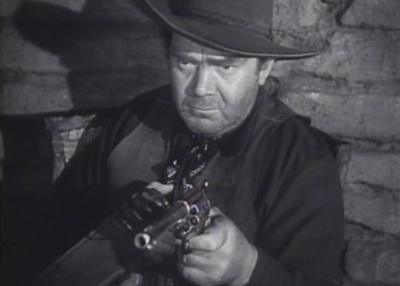
Walter Huston had the role of "Doc Holliday". Back in 1941 Huston had an non screen credited role in his son John's "The Maltese Falcon" as a police captain. The year before this picture Walter Huston was James Cagney's father in the Hollywood version of the life of "George M. Cohan" "Yankee Doodle Dandy". The actor followed this picture co-starring with Errol Flynn and Ann Sheridan in 1943's "Edge of Darkness" and of course his son's 1948 "The Treasure of the Sierra Madre".

The reason "Doc Holliday" was in this screenplay is that Howard Hughes didn't much care for facts, but both box office and a good yarn. In 1956 Hughes turned John Wayne into "Genghis Khan" in "The Conqueror" opposite Susan Hayward as his "Tartar Women".
This story opens with "Pat Garrett's" friend "Doc Holliday" arriving in the town of Lincoln looking for his stolen horse.

The horse thief turns out to be "Billy the Kid". That at first worries "Garrett", but the two gunmen take a liking to each other which worries "Garrett" even more.
Add into the mix Jane Russell as "Rio". That famous scene of Jane Russell in the barn and you have actually a very good "B" Western done by an "A" cast just having some fun.


In fact Howard Hawks did a homage to the scene in his 1967 "El Dorado". It was between James Caan and Michele Carey, below. Adding to the idea that he actually filmed "The Outlaw".

The next night "Doc" steal his horse back and the following day a stranger offers to shoot "Garrett" in the back, if "Billy' will distract him. The suspicious "Billy" guns the man down and is shot himself. "Pat" attempts to arrest him for murder, but "Doc" sides with "Billy". As the two start to leave "Pat Garrett" shoots "Billy" and "Doc" shoots the gun out of the others hand and kills two of "Garrett's" men.
"Doc" and "Billy" flee to "Rio's" aunts house with a posse after them. Instead of killing the unconscious "Kid", "Holliday leaves. For the next month "Rio" nurses "Billy" back to health.
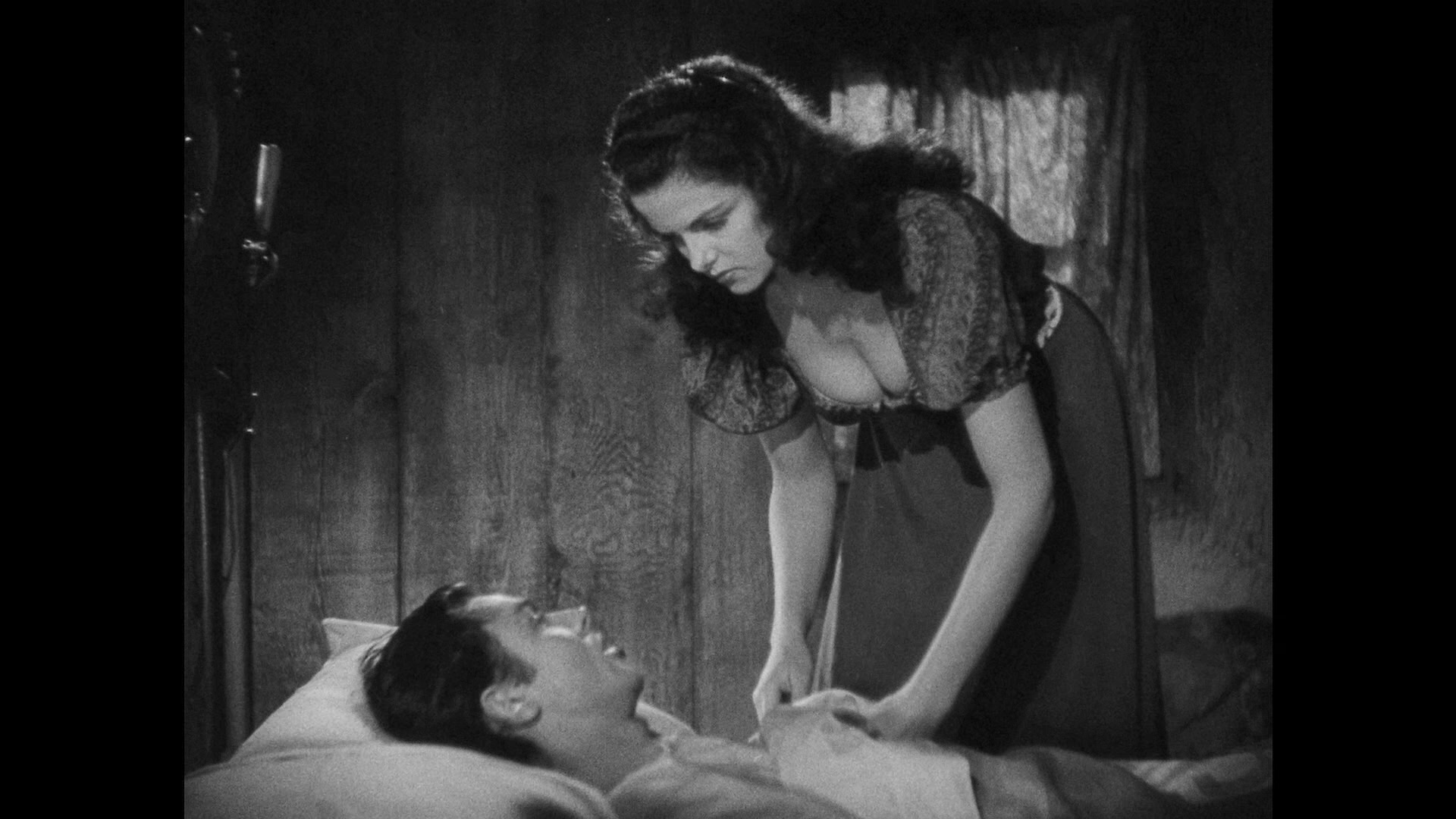
"Rio", who was supposed to have been "Doc's" girlfriend, has fallen in love with "Billy". "Doc" returns to discover the state of things. "Billy" gives him a choice "The Horse", or "Rio". To "Billy's" surprise "Doc" chooses the horse and this angers "Rio".
The two men ride off and are pursued by "Pat" and a posse. Both outlaws think the angry "Rio" told "Pat" how to find them. They pitch a camp for the night and when "Doc" awakes he finds not "Billy", but"Pat Garrett" standing over him with a pair of handcuffs. "Pat" figures "Billy" will go back "Rio's" aunts house, because "The Kid" hasn't figured it out that he loves the girl. "Pat' is able to capture "Billy" and the three men had back towards town.

The three spot Apaches trailing them and "Pat' reluctantly unlocks the handcuffs and gives his prisoners back their gun, but not before he makes "Doc" promise to help make "Billy' give back his own after the Indians are driven off. They are able to allude the Apaches, but "Doc" is the one who refuses to honor his word.
It is "Billy" who attempts to stop him and "Pat" is pleased that the two are going to "Duel It Out", because he believes "Doc" will kill "The Kid". Even though "Doc" shots "Billy" in the hand and ears to provoke him. The young Outlaw keeps his hands away from his guns. "Billy" has realized that "Doc" is a true friend. In anger "Pat' calls out "Doc", but "Holliday" will not shoot him and is instead killed by "Garrett".
After they bury "Doc Holliday" "Garrett" offers to trade "Billy's" guns for "Holliday's". That way "Pat" can claim the grave belongs to "Billy the Kid". Whom everyone in Lincoln knows he was going after. After looking at "Holliday's" guns. "Billy" does a switch and hands an empty one back to "Pat" and then gets the drop of him. He next handcuffs "Garrett", leaves him at the grave site, and rides away with the knowledge that "Pat Garrett" will claim the grave is that of "Billy the Kid". He is even more happy that he now has "Doc Holliday's" horse as his own.
On April 23,1946 the movie finally cleared the "Hays Office" and was released across the country. Of course the Publicity Department went to work.

There was a political factor in the next four 1950's motion pictures. Westerns were considered "Safe" by the "House Committee on Un-American Activities". During their war against Communism along side of Senator Joseph McCarthy. The committee's actions "To Protect American Morality" led to the "Blacklisting" of actors, directors and producers. Who had been, might have been, or were members of the Communist Party. In an attempt to protect themselves from the committee. The major studios started turning out Westerns, Musicals and Science Fiction films like never before and to prove they were stalwarts of American values.
One might consider the first half of 1950 the war of the "William H. Bonney's". As both Universal International Pictures and low budget king Robert L. Lippert released their "True Story" about the young outlaw
THE KID FROM TEXAS released March 1, 1950
.
Universal was first and for the role of "Billy the Kid" they had cast Medal of Honor Winner Audie Murphy. This was the first of several Westerns he would make for the studio and in 1955 Universal International would turn his World War 2 autobiography "To Hell and Back" into a motion picture starring Murphy as himself.

The screenplay was by Robert Hardy Andrews. Among Andrew's screenplays were Boris Karloff's 1936 "The Walking Dead", 1940's "Before I Hang" and 1941's "The Devil Commands". He also wrote the Basil Rathbone and Nigel Bruce 1942 "Sherlock Holmes and the Voice of Terror" and the World War 2 picture 1943's "Bataan". Karl Kamb was the co-screenplay writer. Kamb had written the excellent 1948 Alan Ladd Western "Whispering Smith", butotherwise basically "B" dramas.
The movie was directed by Kurt Neumann. Neumann was known for low budget dramas. However, he directed one classic science fiction movie 1950's "Rocketship X-M" and the classic horror/thriller the original "The Fly" in 1958.
The tag line for this picture read:
The true and savage story of BILLY THE KIDWell they got the names "William Bonney" and "Pat Garrett' right, but that's the end of the "True" part of the tag line.
Audie Murphy's co-star is actress Gale Storm as the fictional "Irene Kain". Storm was a very popular "B" actress who appeared in multi-genre films. Among them 1941's "Jesse James at Bay", 1943's "Revenge of the Zombies" and 1945's "G.I. Honeymoon". From June 9, 1952 Gale Storm had the lead in the very popular television comedy series "My Little Marge" for 126 episodes until May 25, 1955. Starting on September 26, 1956 it was another 126 episodes of "The Gale Storm Show" aka: "Oh, Susana" until March 24, 1960.

Albert Dekker was rancher and lawyer "Alexander Kain". "Kain" is "Irene's" jealous husband and half of "Tunstall" and part of "Murphy". Dekker was the title character in the overlooked science fiction movie "Dr Cyclops". The title comes from one of the lenses in his glasses being broken and the spare hidden by a group of people he shrunk. He was cast as the bad guy in many Westerns including the John Wayne features 1942 "In Old California" and 1943 "In Old Oklahoma".
"Alexander Kain" has a partner named "Roger Jameson", played by Sheppard Strudwick. "Jameson" appears to be half of "John Tunstall" in this film.
The story starts when a gunslinger named "Minniger" goes into the office of "Kain" and "Jameson" to arrest them for murder. They claim that the men killed were cattle rustlers. "Kain" warns he will not stand gunslingers running errands for his competitor "Major Harper". " Harper" is the British rancher, perhaps the other half of "Tunstall" and"Murphy" as this screenplay goes. The character is portrayed by Dennie Hoey best known as "Inspector Lestrade" in the Rathbone and Bruce "Sherlock Holmes" series.
Waiting in the office of "Harper's" man "Sheriff Rand" is "William Bonney". When "Minniger" attempts to take his guns. The kid fires and wounds the other man and kills two other gunslinger's.
This leads to "Jameson" hiring "The Kid", At the ranch he meets "Kain's" wife and the rancher becomes jealous of "Billy" setting up a secondary story line. Along with the tension caused by "Major Harper".

Above Audie Murphy and Sheppard Studwick.
"Jameson" is killed after going to see "Governor Lew Wallace". "Billy" goes after the men responsible and he has to deal not only with "Harper's" men, but "Alexander Kain". Who now sees the opportunity of using the deaths caused by "Billy the Kid" to keep him away from his wife. Meanwhile, "Lew Wallace' hires "Pat Garrett", Frank Wilcox, to bring law and order to Lincoln County.
A posse led by "Garrett" corners "The Kid" in "Kain's" ranch house with his wife and servants. "Billy" is able to get "Kain" to admit to "Irene" that he was partly responsible for the reward against him, because of his jealousy., "Irene" and the servants leave the house. The posse starts a fire to burn "Billy" and one of his men "O'Fallon", Will Geer, out. "Alexander Kain" attempts to shoot "Billy", but a dying "O'Fallon" kills him instead. All of the confusion permits "Billy the Kid" to escape.
Below a very young and prte-"The Waltons" Will Geer as "O'Fallon".

Six weeks later "Pat Garrick" catches up with "William Bonney" at the house that "Irene Kain" is staying at. There is a confrontation between the two men and "Billy the Kid" dies with 21 notches on his guns. So ends
"The true and savage story of BILLY THE KID".
I SHOT BILLY THE KID released July 27, 1950
Producer Robert L: Lippert had great success was Sam Fuller's 1948 "I Shot Jesse James" starring John Ireland as "Bob Ford". So why not two years later make "I Shot Billy the Kid"?
The director was William Berke a low budget action director since 1934. He was known for those 60 minute, or less film series with characters such as "Dick Tracy", "The Falcon" and "Jungle Jim". He also shot some "B" Westerns and was perfect for this script.
That screenplay was by Orville H. Hampton and if his name isn't familiar. Some of his science fiction and horror work are. These include three classics from the 1950's: "Rocketship X-M" in 1950 and two in 1959 "The Four Skulls of Jonathan Drake" and "The Atomic Submarine".
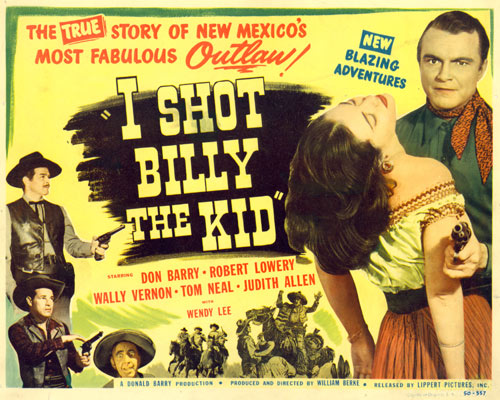
"B" Cowboy actor Don "Red" Barry portrayed "William H. Bonney". Barry had been acting since 1933, but it would be his "B" Western roles and later character Cowboy roles in movies and 1950's television that he is remembered for.

"B" leading man Robert Lowery was "Pat Garrett". Lowery was the second actor to portray "Batman" in the 1949 Chapter Serial "Batman and Robin". He had been the lead in the 1946 classic thriller "House of Horrors" featuring Rondo Hattan as "The Creeper".

The movie opens with an old man entering the cemetery in Old Fort Sumner, New Mexico. He goes to the grave of William H. Bonney and the audience finds out he is "Pat Garrett". Looking upon the headstone he starts to remember the last days of "Billy the Kid".
The movie than switches to the Lincoln County War, but there Hampton gets his history wrong and there is no "John Tunstall", but there is "McSween" as the good rancher "Billy" is working for and his rival is still "Murphy", but there is no "Dolan".
During the final battle between the "Murphy" and "McSween" factions. "Billy" decides to leave and forms his own outlaw gang. Riding across the countryside his gang comes upon "Pat Garrett" fighting off an Indian attack and helps him.
Later in town "Bonney" is shot by the Sheriff and he kills him and his deputy. Both were working for "Murphy". The local towns people cry out for "Justice" aka: "Revenge" against "Billy the Kid". "Garrett" is now the newly appointed Sheriff and he goes to New Mexico Governor "Lew Wallace" and convinces him to give "Billy" a pardon.
In this story "Billy" has a girlfriend named "Francesca", played by Wendy Lee.

"Pat" goes to "Francesca" for help getting the message of the pardon to "Billy". However, he refuses the pardon and continues in a life of crime. This forces "Pat" to go after "The Kid". He is captured by "Garrett" and a posse and brought in for trial. "Pat", "Francesca" and a local priest testify on his behalf, but the judge still sentences "Billy the Kid" to be hanged. While awaiting a possible pardon from Lew Wallace he escapes and is pursued by "Pat" and another posse.
"Billy" is seen entering "Francesca's" house and this is reported to "Garrett". "Pat" enters and "The Kid" draws his gun forcing "Garrett" to shoot and kill him. The film now switches back to "Pat" standing at "Billy's" grave and he turns and leaves.
THE BOY FROM OKLAHOMA released February 27, 1954
This is an interesting "Billy the Kid" movie as "Billy' is secondary, but important to the plot. It is also interesting because of the two actors in the leading roles and the director.
The director was Michael Curtiz. Who prior to this film had directed Fay Wray in 1932's first Technicolor horror movie "Dr. X". that same year Spencer Tracy and Bette Davis in "20,000 Years in Sing Sing", then there was Errol Flynn in 1935's "Captain Blood" and 1938's "The Adventures of Robin Hood". How about Edward G. Robinson, John Garfield and Ida Lupino in the 1941 Jack London story "The Sea Wolf", Humphrey Bogart and Ingrid Bergman in 1942's "Casablanca" and prior to that film. It was song and dance man James Cagney in 1942's "Yankee Doodle Dandy".
The screenplay was by Winston Miller who wrote John Ford's 1946 "My Darling Clementine" and prior to that some solid "B" Westerns starring Gene Autry, Roy Rodgers, Ray "Crash" Corrigan and Charles Starrlett,
Will Rodgers, Jr. portrayed "Sheriff Tom Brewster". A character reminiscent of James Stewart in 1939's "Destry Rides Again".
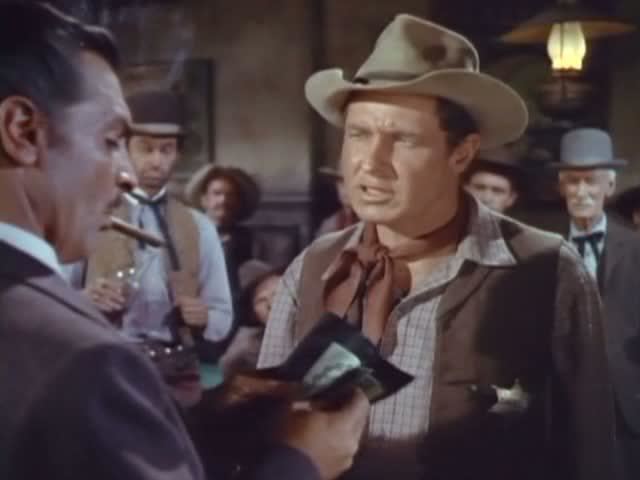
Nancy Olson was "Katie Brannigan". Olson co-starred in 1951's "Force of Arms" opposite William Holden and again the same year the two starred in "Submarine Command". She played John Wayne's wife in 1952's "Big Jim McLain" and was billed third after Jane Wyman and Sterling Hayden in the major 1953 production of Edna Ferber's "So Big" and after this picture co-starred with Rock Hudson in 1955's "Battle Cry".
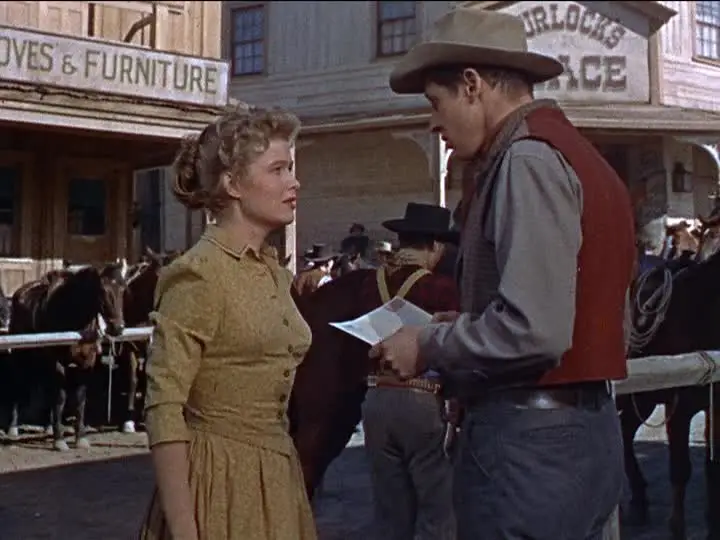
Probably best known for portraying Italian Gangsters on televiosn was Anthony Caruso as the villainous "Mayor Barney Turlock".
Below left to right are Anthony Caruso, Will Rodgers, Jr. and James Griffith, see next film.

This movie could be described as a "Guest Appearance" by "Billy the Kid". Portrayed by Tyler MacGuff seen below next to Anthony Caruso. MacGuff was a regular on 1950's television shows including "The Lone Ranger", "The Adventures of Superman", "Death Valley Days" and"Annie Qakley" along with many "B" Western movies.

The plot has a correspondence school law student coming to the small town of Blue Rock in Lincoln County. Falling in love with "Katie Brannigan", being appointed Sheriff by the crooked down boss "Mayor Turlock" and meeting the bosses cousin "Billy the Kid". As I said "Tom" is like either James Stewart in 1939, or Audie Murphy in the 1954 remake of "Destry Rides Again". As a likable, under estimated, I'd rather use my intelligence than guns Marshall.
In this case as “Billy the Kid” fires his pistol, note he is left handed, at “Tom” to get him to shoot back. The easy going Sheriff quietly just talks to “The Kid” and bores him so much. That to everyone else’s surprise including "Cousin Mayor Turlock". The outlaw turns around, walks out of the saloon and leaves town.
Later “Tom” brings the crooked "Turlock" to justice for the murder of "Kate's" father.
THE LAW VS BILLY THE KID released August 1, 1954

This was a Columbia Picture's production by the man who gave Bert I. Gordon competition in making low budget movies Sam Katzman. Among Katman's films were several Columbia Chapter Serials including 1948'd "Superman", 1949's "Batman and Robin" and 1950's "Atom Man vs Superman". After this film he was executive producer for Ray Harryhausens' 1955 "It Came from Beneath the Sea" and 1956's "Earth vs the Flying Saucers".
Scott Brady was "William Bonney". For a period of time Brady was associated with both "B" and "A" Westerns. Two of those "A's" are considered classics and are director Nicholas Ray's 1954 "Johnny Concho" starring Joan Crawford and Sterling Hayden and 1956's "Maverick Queen" starring Barbara Stanwyck and Barry Sullivan. He was also in the "B plus" Western 1952's "Montana Belle" starring Jane Russell as "Belle Starr". From 1959 through 1961 Scott Brady was televisions "Shotgun Slade" for 78 episodes.
Brady in all black as "Billy" is on the far left of the following photo.
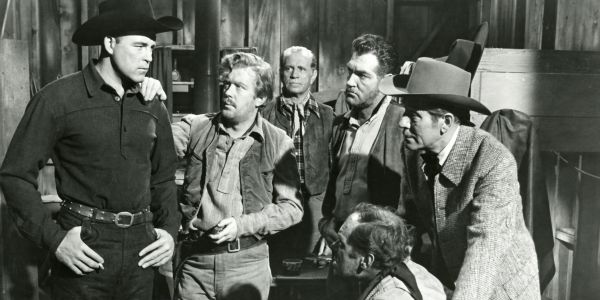
Cow puncher "William Bonney" is denied a days pay, takes the money anyway, an rides away. He is pursued and kills one of the men following him and now is the outlaw "Billy the Kid".
"Bonney" falls in love with "Nita Maxwell" portrayed by Betta St. John. St. John was a familiar supporting actress in some major Hollywood films until she went to London, fell in love and married. Some of those films were the first CinemaScope motion picture 1953's "The Robe" starring Richard Burton and Jean Simmons, the same years "All the Brothers Were Valiant" starring Robert Taylor and Stewart Granger and the 1954 musical "The Student Prince" starring Ann Blythe and Edmund Purdom.
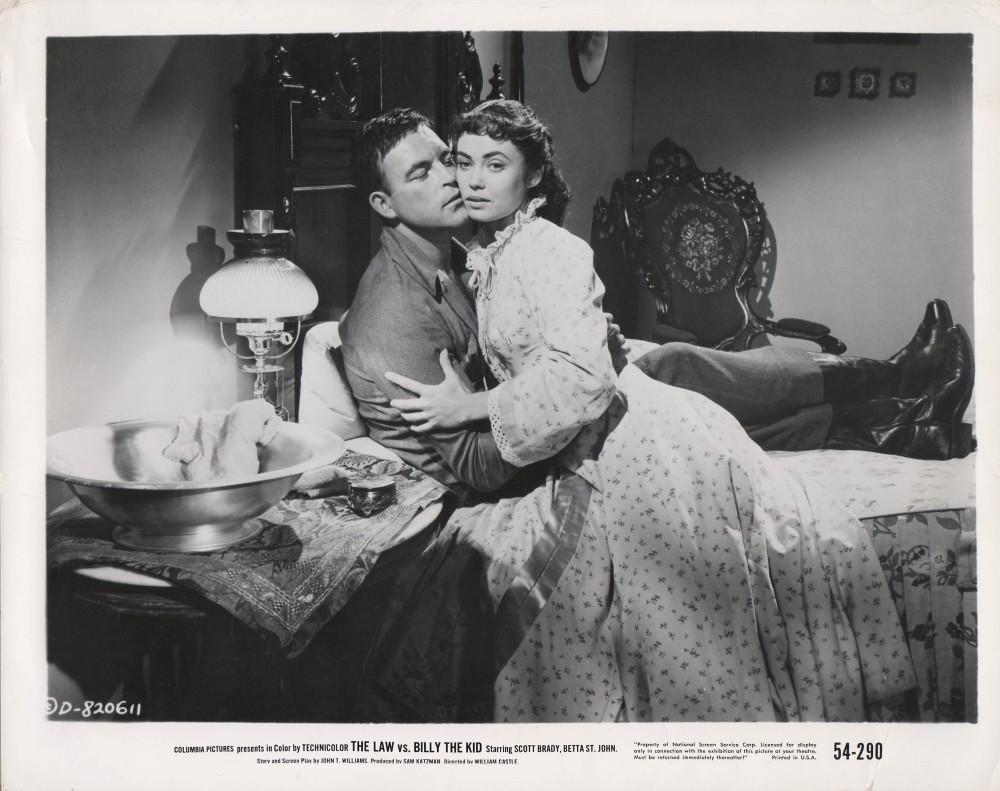
James Griffith portrays "Pat Garrett". Griffith is a very familiar 1950's face in films and especially as the villain in multiple episodes of such 1950's television shows as "The Gene Autry Show", "The Range Rider", "Ramar of the Jungle" and "Death Valley Days".
Below Brady and Griffth.

Alan Hale, Jr. was "Bob Olinger". Hale, second from the left in first still below. He better known too many as "The Skipper", never mentioned first name of "Jonas", on television's "Giligan's Island" for 99 episodes and the sequel. At the start of the 1950's Alan Hale, Jr, had been very busy appearing on television programs such as "The Gene Autry Show", "The Adventures of Wild Bill Hickok", "The Range Rider" and "Captain Video and his Video Rangers".

"Billy's" friend "Pat Garrett" gets him a job on the ranch of "John Tunstall", Paul Cavaugh, and everything is going fine until ranch foreman "Olinger" takes a dislike to "Billy" and beats him up. Above "Olinger' has gone to crooked lawman "Sheriff Watkins", Steve Darrell, to get an old wanted poster on "Billy".
A posse goes looking for "Billy", but kills "Tunstall" by mistake. "The Kid" guns down the men who killed his boss and becomes an outlaw again, but in love with "Nita". The New Mexico governor wants to replace "Watkins" with "Garrett", but "Pat" initially declines until the governor states he's plans to declare marital law and order "Billy the Kid" killed on sight.
"Pat" meets "Billy" and convinces him to come in peacefully, but "Olinger" wants "Billy" hung and stirs up the townspeople. "Billy" kills "Olinger" and heads for "Nita's" house being followed by "Pat". He has a wedding ring and plans to start a new life in Mexico with her, but "Pat" arrives and kills him.
By 1958 Senator Joseph McCarthy had met his fate at the "Army, McCarthy Hearings", back in 1954, that were televised across the country. The "House Committee on Un-American Activities" would not be disbanded until 1969, but its power was dwindling daily.
The 1950's ended with a new take on "William H. Bonney".
THE LEFT HANDED GUN released May 17, 1958
This motion picture could be considered either the psychological "William H. Bonnry', or "The Lee Strasberg Method Acting Billy the Kid".
The above poster's tag line goes to that psychological concept:
Whether or not William Bonney was a juvenile tough in New York back-alleys is very debatable. Seeing as he was only 11 years old when his mother and her second husband moved to Wichita, Kansas in 1870. His mother and her two sons had moved from New York City to Indianapolis, Indiana, before that as I related above.
The movie was directed by Arthur Penn. Penn had been directing television shows since 1953 and "The Left Handed Gun" was his first motion picture. He would go on to direct such films as 1962's "The Miracle Worker, 1967's "Bonnie and Clyde", 1969's "Alice's Restaurant" and 1970's "Little Big Man" and a favorite of mine "The Missouri Breaks".
The screenplay was by Leslie Stevens. Stevens was basically a television writer and this film was his only motion picture screenplay.
However, it was based upon a novel and play by Gore Vidal. At this time Vidal had also just been writing for television. The same year of this picture Vidal wrote the screenplay for Jose Ferrer's "I Accuse". The story of the French military trial of Alfred Dreyfus motivated by religious prejudiced against the Jewish Dreyfus . In 1959 Gore Vidal wrote the screenplay for "Suddenly Last Summer" based upon the Tennessee Williams play and in 1960 wrote the Broadway play "Visit to a Small Planet" that Jerry Lewis would turn into a motion picture. In 1970 Gore Vidal shocked America with his novel "Myra Breckenridge" that would be turned into a motion picture starring Rachel Welch.
Paul Newman, as I said, was "Billy the Kid". By 1958 the actor had appeared on 17 different television programs and some multiple times. His motion picture career started with the 1954 Biblical film "The Silver Chalice". That is still known for the multiple acting styles of the cast conflicting and distracting from the other actor's roles. Newman's second motion picture was the excellent 1956 "Somebody Up There Likes" as Boxer "Rocky Graziano".

Lita Milan was "Celsa". Milan had also been on many television shows and a few "B" movies. She was typed case as a "Sultry Women". Two of her best performances were the Anthony Quinn Western 1957's "The Ride Back" and the role of Seminole Chief Osceola's wife in 1957's "Naked in the Sun".
John Dehner was "Pat Garrick". Dehner's career began as an animator for Walt Disney. He appeared in a 1941 Disney cartoon "Pete's Dragon". His films included two Rodgers and Hammerstein musicals: 1945's "State Fair" and 1956's "Carousel". Dehner's motion picture appearances included many genres such as 1946's "The Cat Man of Paris", the Charles Starrlett Western 1949's "Bandits of El Dorado", 1950's "Rogues of Sherwood Forest", 1952's "Aladdin and his Lamp" and 1954's "The Bowery Boys Meet the Monsters".
This is William Bonney, a juvenile "tough" from the back-alleys of New York......a teenager wanted dead or alive throughout the West.While the casting of Paul Newman at this time goes to "The Lee Strasberg Method Acting".
Whether or not William Bonney was a juvenile tough in New York back-alleys is very debatable. Seeing as he was only 11 years old when his mother and her second husband moved to Wichita, Kansas in 1870. His mother and her two sons had moved from New York City to Indianapolis, Indiana, before that as I related above.
The movie was directed by Arthur Penn. Penn had been directing television shows since 1953 and "The Left Handed Gun" was his first motion picture. He would go on to direct such films as 1962's "The Miracle Worker, 1967's "Bonnie and Clyde", 1969's "Alice's Restaurant" and 1970's "Little Big Man" and a favorite of mine "The Missouri Breaks".
The screenplay was by Leslie Stevens. Stevens was basically a television writer and this film was his only motion picture screenplay.
However, it was based upon a novel and play by Gore Vidal. At this time Vidal had also just been writing for television. The same year of this picture Vidal wrote the screenplay for Jose Ferrer's "I Accuse". The story of the French military trial of Alfred Dreyfus motivated by religious prejudiced against the Jewish Dreyfus . In 1959 Gore Vidal wrote the screenplay for "Suddenly Last Summer" based upon the Tennessee Williams play and in 1960 wrote the Broadway play "Visit to a Small Planet" that Jerry Lewis would turn into a motion picture. In 1970 Gore Vidal shocked America with his novel "Myra Breckenridge" that would be turned into a motion picture starring Rachel Welch.
Paul Newman, as I said, was "Billy the Kid". By 1958 the actor had appeared on 17 different television programs and some multiple times. His motion picture career started with the 1954 Biblical film "The Silver Chalice". That is still known for the multiple acting styles of the cast conflicting and distracting from the other actor's roles. Newman's second motion picture was the excellent 1956 "Somebody Up There Likes" as Boxer "Rocky Graziano".

Lita Milan was "Celsa". Milan had also been on many television shows and a few "B" movies. She was typed case as a "Sultry Women". Two of her best performances were the Anthony Quinn Western 1957's "The Ride Back" and the role of Seminole Chief Osceola's wife in 1957's "Naked in the Sun".
John Dehner was "Pat Garrick". Dehner's career began as an animator for Walt Disney. He appeared in a 1941 Disney cartoon "Pete's Dragon". His films included two Rodgers and Hammerstein musicals: 1945's "State Fair" and 1956's "Carousel". Dehner's motion picture appearances included many genres such as 1946's "The Cat Man of Paris", the Charles Starrlett Western 1949's "Bandits of El Dorado", 1950's "Rogues of Sherwood Forest", 1952's "Aladdin and his Lamp" and 1954's "The Bowery Boys Meet the Monsters".
Hurd Hatfield portrays "Moutrie". Hatfield starred in the excellent 1945 "The Picture of Dorian Gray", was one of the scientists working on the Manhattan project in 1947's "The Beginning, or the End", in 1949 he started appearing on television programs along with motion pictures. In 1961 Hatfield was "Pontius Pilate" in Nicholas Ray's "King of Kings".
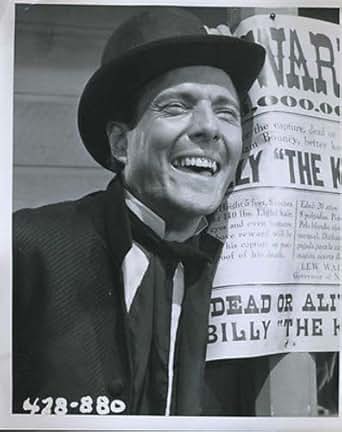
The movie opens with "William Bonney" walking across open range without a horse. He comes upon cattle owned by "John Tunstall", actor Colin Keith-Johnston, seen below with Paul Newman, who gives him a horse and offers "Billy" a job.
An older cowboy recognizes "Bonney" as a young man who once killed another for insulting his mother. "Billy" becomes close to "Tunstall".and when the "Englishman" decides to ride alone into Lincoln. "The Kid" volunteers to go along as protection, "Tunstall" refuses the offer, and is murdered by "Sheriff Brady" and men working for the rival rancher, this time named "Morton", Richard Griffith.
After "John Tunstall's" funeral "Billy" wants to go after the murderers and kill them, but "John Tunstall's" friends attempt to talk him out of it. One of them is "Alexander McSween", actor John Dierkes,

"Billy" shows two cowhands "Tom Folliard", played by James Best, his last name was really "O'Folliard", and "Charlie Bowdre", James Gongdon, four bullets. One each for "Morton" and "Brady" and the two killers"Hill" and "Moon".
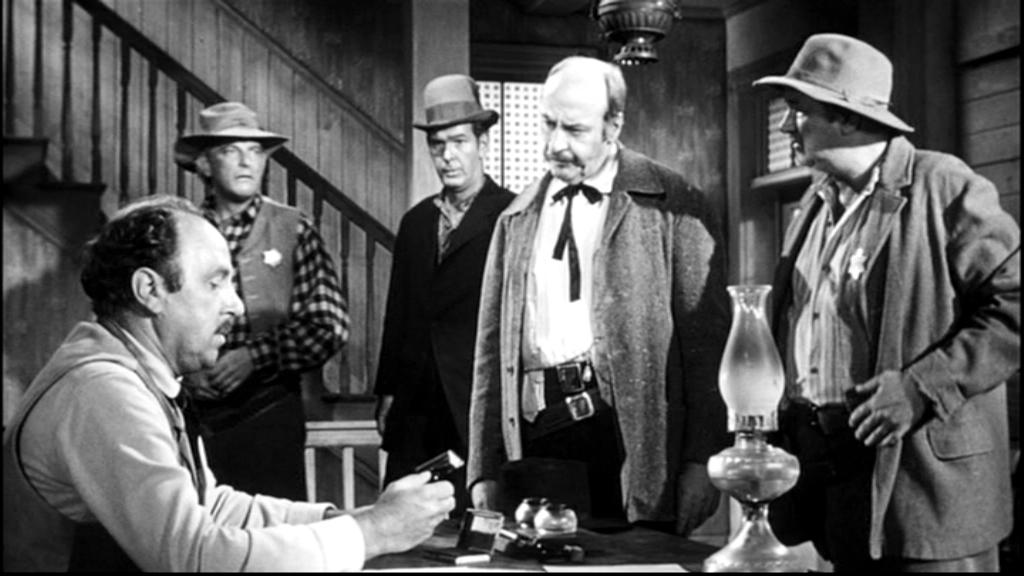
Above in foreground are Robert Foulk as "Sheriff Brady", Robert Griffith as "Morton", Wally Brown as "Moon". In the background are Denver Pyle as "Ollinger" and Robert Anderson as "Hill". Note the misspelling in the screenplay of "Bob Olinger" as "Ollinger".
"Billy" and "Tom" confront "Morton" and "Brady" in the street. "Billy" outdraws both men and kills them and runs into "McSween's" house.

"Billy" can't believe that "McSween" calls him a murderer, but then the house is set afire by townspeople. As "Mrs. McSween", who wasn't in the house, runs up and watches her husband burn to death. It is believed that both "Billy" and "McSween" died in the fire, but the young outlaw had escaped and joins "Tom" on the trail.
The two ride to Maderio, Mexico to see a gun maker "Billy" knows. They are soon joined by "Charlie" and another old friend of "William Bonney" shows up. His name is "Pat Garrett". Shortly, thereafter the group is informed of the amnesty offered by Governor Lee Wallace. "Tom" and "Charlie" convince "Billy" to go to Lincoln with them and seek the amnesty being offered. What his friends don't know is that "Bonney" still wants to kill "Moon" and "Hill".
In the Sheriff's office "Billy" meets with "Moon". Who pleads with him that he was only following "Brady's" orders. "Moon" adds he's sorry and considers everything over. While "The Kid" considers "Moon's" words "Charlie" breaks the amnesty by shooting "Moon" in front of "Tom" and "Billy".

The three head for a hideout "Billy" knows about. Meanwhile, "Hill", also a friend of "Pat Garrett", wants "Pat" to come to Lincoln and take the Sheriff's position. "Garrett" refuses as he is about to get married back in Maderio. On the wedding day "Billy Bonney", "Tom Folliard" and "Charlie Boudre" ride into Maderio.
"Pat" asks "Billy" not to cause any trouble and he agrees.

While having his photo taken "Bill" sees "Hill" in the distance. The other man yells the same story as "Moon". It was "Brady" who ordered him to kill "Tunstall" and he really didn't want to do it. Adding he wouldn't draw on anyone that didn't draw first.
Suddenly, "Hill" starts to go for his gun and "Billy" draws faster and kills him. However, this starts a melee of guns going off and "Tom" is shot.

That this happened on his wedding day enrages "Pat Garrett" who now forms a posse, as the new Sheriff, and starts to pursue the three men, While this is going on the three outlaws have gone to their hideout and are treating "Tom".
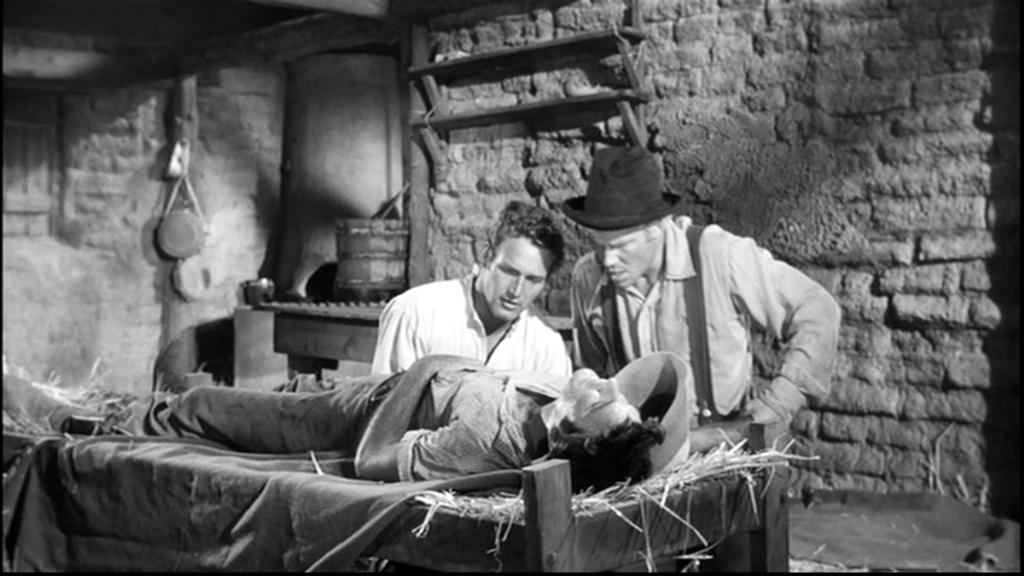
"Tom" wants to go home after recovering and the other two help him onto a horse with supplies for the long ride back. Unbeknownst "Pat" has surrounded the hideout and as "Tom" reaches the top of a hill and waves good-bye. A shot gun blast rings out killing him from "Orllinger's" weapon. "Charlie" is killed and "Billy" surrenders.

"William H. Bonney" is tried and sentenced to be hung. As people come to the show "Billy" meets a man named "Moultrie". Who is writing Dime Novels about the exploits of "Billy the Kid". Before "Billy" is executed he kills a friendly young guard. During his escape "Billy" also murders "Orllinger".He next heads into Mexico and meets "Moultrie" once again. The writer shows him some of the books that are telling the myth of "William H. Bonney" aka: "Billy the Kid".
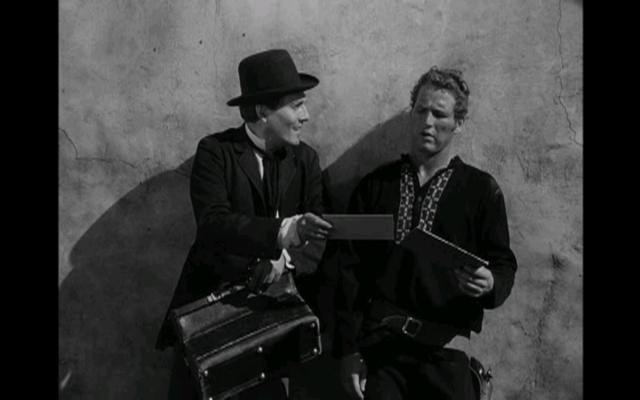
"Pat" arrives and locates "Billy". Who is standing in a darkened doorway.

"Garrett" orders "The Kid" to drop his gun. As "Billy" moves his left hand as if to draw his pistol. "Pat Garrett" shoots and kills him, but discovers "Billy's" gun is still in the holster.

BILLY THE KID VS DRACULA released April 10, 1966
On May 1, 1959 an interesting and very good crossover motion picture opened. It was entitled "Curse of the Undead"and starred Eric Fleming as a small town minister. In January he had started playing "Gil Favor" on a television show called "Rawhide". Michael Pate, known for portraying Apache Chief "Vittoro" in John Wayne's 1953 3-D Western "Hondo", was "Drago Robles" a vampire. What made this film a crossover was that the story was a Western and "Robles" was dressed in all black and a feared gunfighter. Actually the son of the original Spanish land granted owner of the town's location.
On April 14, 1966 producer Caroll Case and director William Beaudine released a double bill both set in the the West with a horror plot. One film was entitled "Jesse James Meets Frankenstein's Daughter" and the second was "Billy the Kid vs Dracula".

Carl Hitterman wrote the screenplay. Hitterman had produced two very good director Sam Fueller motion pictures: 1949's " I Shot Jesse James" starring John Ireland and 1950's "The Baron of Arizona" starring Vincent Price. He wrote and produced 1950's "The Return of Jesse James" also starring John Ireland and featuring actor Henry Hull, 1935's "Werewolf of London" and 1940's "The Return of Frank James".
.
This motion picture wasn't a "Curse of the Undead" and looked like less than the six days it took to make.
"Dracula" going by the name of "James Underhill" was portrayed by John Carradine. Who looked way older than his 60 years of age.
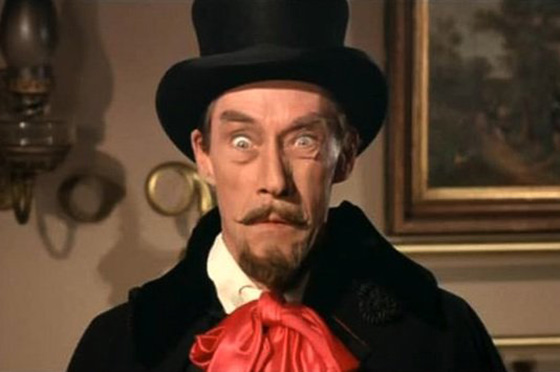
Carradine had portrayed "Dracula", called "Baron Latos" in Universal Pictures 1944 "House of Frankenstein" and was brought back to life, or death, in 1945's "House of Dracula". At the time of this picture he was guest starring on many television series. In 1966 Carradine was seen in episodes of "The Beverly Hillbillies", "The Munsters" and two Western series "Laredo" and the forgotten "The Legend of Jesse James".
Portraying "Billy the Kid" was Chuck Courtney. The actor was appearing in Western television series and had non screen credited roles in several movies. As a stunt man he would double in 49 motion pictures

Portraying "Billy's" fiancee:Elizabeth 'Betty' Bentley" and the target of "Dracula" was Melinda Casey billed as Melinda Plowman. She was basically a television actress and later became a stage manager for television productions.

The basic "C" movie plot has "Mr. Underhill" attack a wagon train and kill a young girl. Her parents, from the old country, settle in a small town in which "Billy the Kid" is an upstanding citizen. Enter "Dracula" wanting "Betty" and the first girl's parents figuring out who he is and warning "Billy the Kid". In the end our hero with his gun having no affect on the Count. So in frustration "Billy" throws it at "Dracula" and, surprise, it knocks him senseless and "Billy" stakes him in the heart and saves "Betty".


CHISUM released July 29, 1970
Enter John Wayne as "Cattle Baron John Chisum".
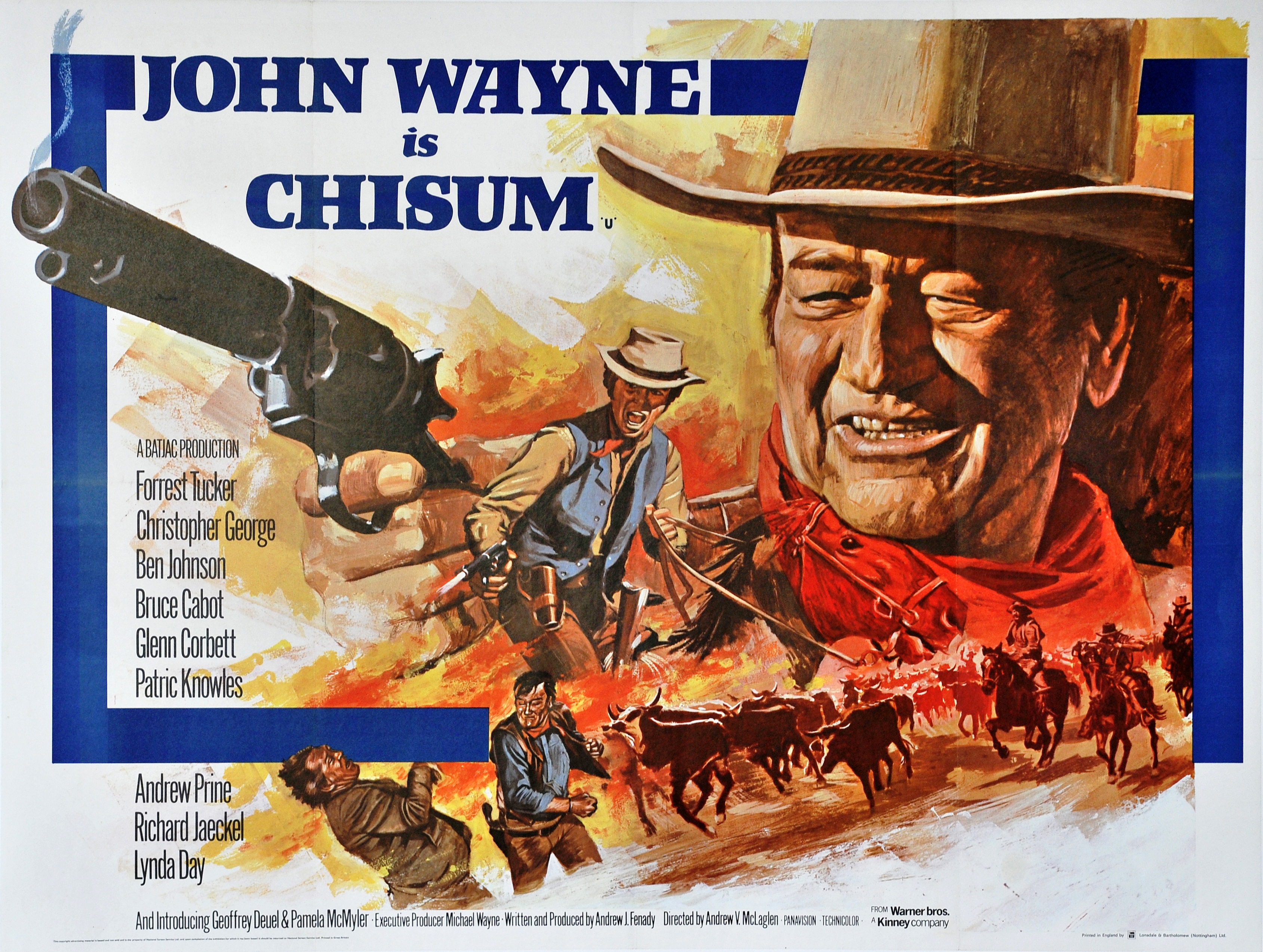
This is a fictionalized look at the Lincoln County War directed by Andrew V. McLagen. McLagen was directing for two reasons. One Wayne liked his work which included several Western television shows and the John Wayne and Maureen O'Hara 1963 "McLintock", two James Stewart classics 1965's "Shenandoah" and 1966's "The Rare Breed" and two other Wayne features 1968's "Hellfighters" and 1969's "The Undefeated". The second reason John Wayne wanted McLagen was that he was the son of Victor McLagen, John Ford's cavalry trilogy 1948's "Fort Apache", 1949's "She Wore a Yellow Ribbon" and 1950's "Rio Grande". Not to forget 1952's "The Quiet Man".
The film was produced and written by Andrew Fenady. He was known for producing and writing the Western television series "The Rebel", the series "Hondo" and "Branded" among other work.
As I said "John Chisum" was portrayed by John Wayne. He had just been seen opposite Rock Hudson in 1969's "The Undefeated" and would follow this picture with 1970's "Rio Lobo".
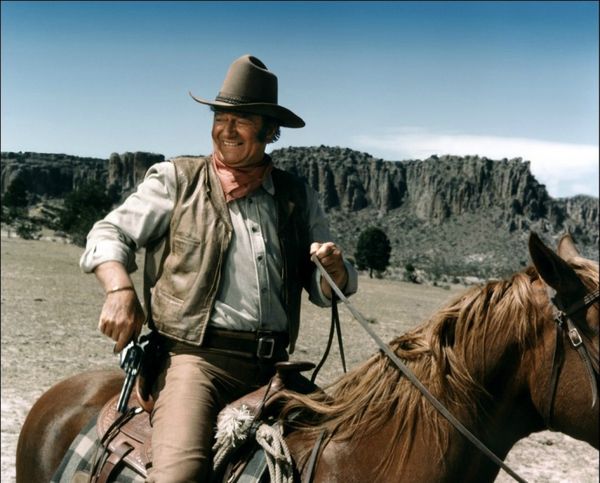
Forrest Tucker was "Lawrence Murphy". In 1949 Tucker had been in the John Wayne picture "Sands of Iwo Jima". By this time Tucker was seen as guest stars on television and of course back in 1965 "F-Troop". Earlier in 1970 he was in the Lee Van Cleef Western "Barquero".

Andrew Prine was "Alex McSween". Prine was basically a television actor except for the 1966 comedy-Western "Texas Across the River" starring Dean Martin.

Above is Prine with Lynda Day (George) as his wife "Sue McSween. Below the real Sue McSween. Day George was a familiar face on television.


Above on the left is Glenn Corbett as "Pat Garrick" and on the right "Geoffrey Duel" as "Billy the Kid". Corbett had been seen in the 1960 James Stewart World War 2 movie "The Mountain Road" and the same years Korean War movie "All the Young Men" starring Alan Ladd and Sidney Poitier, the following year he starred in William Castle's "Homicidal" and in 1963 was traveling on televisions "Route 66". While Duel had just been making the television rounds before "Chisum" and would return after.
Patrick Knowles was "Henry Tunstall". Knowles had been in director Michael Curtiz's 1936 "The Charge of the Light Brigade" starring Errol Flynn and Olivia de Havilland, he was "Will Scarlet" in Curtiz's 1939 "The Adventures of Robin Hood" also starring Flynn and de Havilland,. In 1941 Knowles was part of John Ford's ensemble cast in "How Green Was My Valley" and was "Dr. Frank Mannering" in Universal Studios 1943 "Frankenstein Meets the Wolf Man". He moved mainly to television in the 1950's.

Edward Faulkner was "James Joseph 'John' Dolan". Faulkner was a television actor appearing on many Western series and dramas. His first major motion picture was James Stewart's 1965 "Shenandoah". He was in John Wayne's 1968 "The Green Berets", the same years "Hellfighters" and 1969's "The Undefeated".

Bruce Cabot would portray "Sheriff William J. Brady". Cabot of course was "John Driscoll" in 1933's "King Kong". He became a regular in "B" Westerns and some dramas. He was also seen in John Wayne's 1947 "Angel and the Badman", a 1959 Steve Reeves Italian sword and sandal epic "Goliath and the Barbarians". the same years "John Paul Jones" starring Robert Stack, then again with Wayne in 1962's "Hatari", 1963's "McLintock", 1965's "In Harms Way", 1967's "The War Wagon", 1968's "The Green Berets", that same years "Hellfighters" and 1969's "The Undefeated".

Christoper George, on the right below, was the fictional bounty hunter "Dan Nodeen". Some of this character reflects the real "Pat Garrett". George, husband of Lynda Day, was still being seen in his television series "The Immortal" from 1969. His other successful television series "The Ray Patrol" had ended in 1968 after a two year run.
Richard Jaeckel, on the left below, was the real "Jesse Evans". Jaeckel had been in John Wayne's 1940 "Sands of Iwo Jima", was the MP Sergeant Lee Marvin put in charge of 1967's "The Dirty Dozen" and had been in the cult science fiction film 1968's "The Green Slime" In 1969 Richard Jaeckel was in the cast of Toho Studio's "Latitude Zero".

The real "Evans", seen below in 1853, formed the "Jesse Evans Gang". They were hired by "Lawrence Murphy" during the Lincoln Country war. In 1882 "Jesse Evans" just disappeared and was never seen again
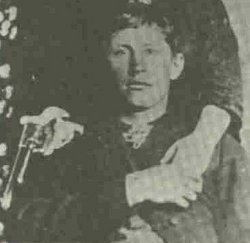
On the early Western television series "Tales of the Century". Starring "B" Cowboy actor Jim Davis as Railroad Detective "Matt Clark". Richard Jaeckel portrayed "Billy the Kid" in one of the first episodes of Season One shown January 30, 1954. Below a rare still of the actor as "The Kid".

Ben Johnson was "James Pepper". Johnson had a non screen credited role as a "Deputy" in 1943's "The Outlaw" and appeared with Wayne in 1948's "3 Godfathers", 1949's "She Wore A Yellow Ribbon" and 1950's "Rio Grande". He co-starred with Terry Moore and the title character of 1949's "Mighty Joe Young" and appeared in Sam Peckinpaw's 1969 "The Wild Bunch" and 1972's "The Getaway". Johnson was the train conductor in the Jamie Lee Curtis thriller from 1980 "Terror Train" and chased Goldie Hawn across Texas in Steven Spielberg's 1974 "The Sugarland Express".

John Agar was "Amos Patton". Agar was also in John Wayne's 1949 "Sands of Iwo Jima". However. before that he was in John Ford's 1948 Fort Apache" in which he married his co-star Shirley Temple until a messy divorce. In 1949 Agar was in "She Wore a Yellow Ribbon". His career hit the slides until he became a Cult 1950's science fiction star with 1955's "Tarantula" and the 3-D "Revenge of the Creature". 1956's "The Mole People" and in 1957 "The Daughter of Dr. Jekyll" and "The Brain from Planet Arous".

Pamela McMyler portrayed "John Chisum's" niece "Sallie Lucy Chisum". Prior to this picture McMyler was mainly on television and only appeared in one previous feature film 1968's "The Boston Strangler" starring Tony Curtis as "Albert DeSalvo". After this picture she returned to television work.

The story opens with "Lawrence Murphy" tipping off some Mexican rustlers about the location of some of "Chisum's" horses. They're stopped when "Chisum" and "Pepper" are helped by a young rider that happens to be passing by. Afterwards he introduces himself as "William Bonney".
"Booney" goes to work for "Chisum's" English neighbor "Henry Tunstall" and when "Chisum's" niece "Sallie" arrives. The young outlaw/cowhand falls for her. Meanwhile, "Lawrence Murphy" is controlling all the supplies and store goods and selling them to people at outlandish prices. Also a rancher "Murphy" acts as a town boss and appoints his own Sheriff "William Brady" and his deputies. He brings in his own back east lawyer "Alex McSween" accompanied by his wife "Sue". However, "McSween" realizes what is going on and switches sides to "Chisum" and "Tunstall".
Before "Chisum's" can sell his cattle a buffalo hunter named "Pat Garrett" warns him that he heard that "Murphy's" men are planning to steal them.

"Garrett" goes to work for "Chisum" and "Tunstall", befriends "Bonney" and the two stop "Murphy's" plan."Pat" also falls for "Sallie Chisum", Meanwhile, fed up with "Lawrence Murphy", "Henry Tunstall" heads for Santa Fe to speak to the governor and is murdered. "Chisum" and "Garrett" hunt down "Brady's" deputies who committed the murder and bring them to town. "Billy" doesn't believe the deputies will get a fair trial in "Lawrence Murphy's" town. "The Kid" surprises "Pat, by gunning them down and the Lincoln County War has begun. Next "Billy the Kid" goes to the Sheriff's office and murders "Brady" and "Dan Nodeen" is appointed the new Sheriff to get "William Booney".
"Billy' breaks into "Alex McSween's" store to steal some dynamite for further revenge. "Alex" attempts to stop him, but "Nodeen" and some men surround the store. "Sue McSween" is permitted to leave, but not "Alex" and "Billy". "The Kid" is able to slip out, but the unharmed "McSween" comes out of the store and is murdered by "Nodeen".
"Sue McSween" goes to "Chisum" and tells him what's happening. The rancher gets his men together and they head into town. He finds the way barricaded by "Nodeen".

"Chisum" has his men stampede the cattle in the railroad corrals and then locates "Lawrence Murphy". The two have a fist fight in the upper rooms of a saloon and both fall off a balcony, but "Murphy" is impaled on the horns of a steer. "Dan Nodeen" flees town being pursued by "Billy the Kid".
The movie ends with "Pat Garrett" now Sheriff leaving to get his friend, but he is accompanied by "Sallie Chisum" and it is implied they will be settling down together.
The real "Sallie Chisum" moved to her Uncle's ranch with her father and brothers from Texas/ Her mother had recently passed away and "Sallie" would eventually marry Balwin G. Stegman and raise a family.
DIRTY LITTLE BILLY released November 1972

This was the first motion picture written and directed by Stan Dragoti. Dragoti would only make six including George Hamilton's "Dracula" comedy 1979's "Love at First Bite", the Michael Keaton 1983 "Mr. Mom" and the 1985 Tom Hanks "The Man With One Red Shoe".
Portraying "Billy" was Michael J. Pollard. Pollard had been making the television rounds since 1958 until Roger Corman cast him in 1966's "The Wild Angels" starring Peter Fonda and Nancy Sinatra. The following year Pollard made a small name for himself in Arthur Penn's "Bonnie and Clyde" starring Warren Beatty and Faye Dunaway.

The film has been described as an American Italian Spaghetti Western and very realistic in its look. The problem of this "True Story" of the events leading up to Henry McCarty becoming "Billy the Kid" are all false.
The screenplay has "Catherine McCarty" with his step father "Henry McCarty", not Henry Atrim, moving from New York City directly to Coffeyville, Kansas not Witchita and becoming farmers. Henry Atrim is in the movie as "Ben Atrim" the major of Coffeyville. Also Pollard is playing "Billy McCarty" not "Henry".
The film depicts the future "William H. Booney's" step father as abusive and "Billy" considering himself a New York City boy. He forms a small gang and they take on the town's gang leader portrayed by a non on screen credited Nick Nolte in his first motion picture.


Also, as I wrote, Henry McCarty was orphaned at the age of 14 after his mother had mother died and by 16 he was being arrested for theft. The date of his step father's death is unknown. However, in this picture there is a funeral scene for "Billy's" step father attended by his mother. The town Mayor "Ben Atrim" is there to console her and she remains alive and married to him at the end of the motion picture.
The movie ends with a confrontation with an outlaw known as "Big Jim McDaniels" and "Billy McCarty" becomes "Billy the Kid", not "William H. Bonney".
PAT GARRETT AND BILLY THE KID released May 23, 1973

The movie opens with "William Bonney" walking across open range without a horse. He comes upon cattle owned by "John Tunstall", actor Colin Keith-Johnston, seen below with Paul Newman, who gives him a horse and offers "Billy" a job.
An older cowboy recognizes "Bonney" as a young man who once killed another for insulting his mother. "Billy" becomes close to "Tunstall".and when the "Englishman" decides to ride alone into Lincoln. "The Kid" volunteers to go along as protection, "Tunstall" refuses the offer, and is murdered by "Sheriff Brady" and men working for the rival rancher, this time named "Morton", Richard Griffith.
After "John Tunstall's" funeral "Billy" wants to go after the murderers and kill them, but "John Tunstall's" friends attempt to talk him out of it. One of them is "Alexander McSween", actor John Dierkes,

"Billy" shows two cowhands "Tom Folliard", played by James Best, his last name was really "O'Folliard", and "Charlie Bowdre", James Gongdon, four bullets. One each for "Morton" and "Brady" and the two killers"Hill" and "Moon".

Above in foreground are Robert Foulk as "Sheriff Brady", Robert Griffith as "Morton", Wally Brown as "Moon". In the background are Denver Pyle as "Ollinger" and Robert Anderson as "Hill". Note the misspelling in the screenplay of "Bob Olinger" as "Ollinger".
"Billy" and "Tom" confront "Morton" and "Brady" in the street. "Billy" outdraws both men and kills them and runs into "McSween's" house.

"Billy" can't believe that "McSween" calls him a murderer, but then the house is set afire by townspeople. As "Mrs. McSween", who wasn't in the house, runs up and watches her husband burn to death. It is believed that both "Billy" and "McSween" died in the fire, but the young outlaw had escaped and joins "Tom" on the trail.
The two ride to Maderio, Mexico to see a gun maker "Billy" knows. They are soon joined by "Charlie" and another old friend of "William Bonney" shows up. His name is "Pat Garrett". Shortly, thereafter the group is informed of the amnesty offered by Governor Lee Wallace. "Tom" and "Charlie" convince "Billy" to go to Lincoln with them and seek the amnesty being offered. What his friends don't know is that "Bonney" still wants to kill "Moon" and "Hill".
In the Sheriff's office "Billy" meets with "Moon". Who pleads with him that he was only following "Brady's" orders. "Moon" adds he's sorry and considers everything over. While "The Kid" considers "Moon's" words "Charlie" breaks the amnesty by shooting "Moon" in front of "Tom" and "Billy".

The three head for a hideout "Billy" knows about. Meanwhile, "Hill", also a friend of "Pat Garrett", wants "Pat" to come to Lincoln and take the Sheriff's position. "Garrett" refuses as he is about to get married back in Maderio. On the wedding day "Billy Bonney", "Tom Folliard" and "Charlie Boudre" ride into Maderio.
"Pat" asks "Billy" not to cause any trouble and he agrees.

While having his photo taken "Bill" sees "Hill" in the distance. The other man yells the same story as "Moon". It was "Brady" who ordered him to kill "Tunstall" and he really didn't want to do it. Adding he wouldn't draw on anyone that didn't draw first.
Suddenly, "Hill" starts to go for his gun and "Billy" draws faster and kills him. However, this starts a melee of guns going off and "Tom" is shot.

That this happened on his wedding day enrages "Pat Garrett" who now forms a posse, as the new Sheriff, and starts to pursue the three men, While this is going on the three outlaws have gone to their hideout and are treating "Tom".

"Tom" wants to go home after recovering and the other two help him onto a horse with supplies for the long ride back. Unbeknownst "Pat" has surrounded the hideout and as "Tom" reaches the top of a hill and waves good-bye. A shot gun blast rings out killing him from "Orllinger's" weapon. "Charlie" is killed and "Billy" surrenders.

"William H. Bonney" is tried and sentenced to be hung. As people come to the show "Billy" meets a man named "Moultrie". Who is writing Dime Novels about the exploits of "Billy the Kid". Before "Billy" is executed he kills a friendly young guard. During his escape "Billy" also murders "Orllinger".He next heads into Mexico and meets "Moultrie" once again. The writer shows him some of the books that are telling the myth of "William H. Bonney" aka: "Billy the Kid".

"Pat" arrives and locates "Billy". Who is standing in a darkened doorway.

"Garrett" orders "The Kid" to drop his gun. As "Billy" moves his left hand as if to draw his pistol. "Pat Garrett" shoots and kills him, but discovers "Billy's" gun is still in the holster.

BILLY THE KID VS DRACULA released April 10, 1966
On May 1, 1959 an interesting and very good crossover motion picture opened. It was entitled "Curse of the Undead"and starred Eric Fleming as a small town minister. In January he had started playing "Gil Favor" on a television show called "Rawhide". Michael Pate, known for portraying Apache Chief "Vittoro" in John Wayne's 1953 3-D Western "Hondo", was "Drago Robles" a vampire. What made this film a crossover was that the story was a Western and "Robles" was dressed in all black and a feared gunfighter. Actually the son of the original Spanish land granted owner of the town's location.
On April 14, 1966 producer Caroll Case and director William Beaudine released a double bill both set in the the West with a horror plot. One film was entitled "Jesse James Meets Frankenstein's Daughter" and the second was "Billy the Kid vs Dracula".

Carl Hitterman wrote the screenplay. Hitterman had produced two very good director Sam Fueller motion pictures: 1949's " I Shot Jesse James" starring John Ireland and 1950's "The Baron of Arizona" starring Vincent Price. He wrote and produced 1950's "The Return of Jesse James" also starring John Ireland and featuring actor Henry Hull, 1935's "Werewolf of London" and 1940's "The Return of Frank James".
.
This motion picture wasn't a "Curse of the Undead" and looked like less than the six days it took to make.
"Dracula" going by the name of "James Underhill" was portrayed by John Carradine. Who looked way older than his 60 years of age.

Carradine had portrayed "Dracula", called "Baron Latos" in Universal Pictures 1944 "House of Frankenstein" and was brought back to life, or death, in 1945's "House of Dracula". At the time of this picture he was guest starring on many television series. In 1966 Carradine was seen in episodes of "The Beverly Hillbillies", "The Munsters" and two Western series "Laredo" and the forgotten "The Legend of Jesse James".
Portraying "Billy the Kid" was Chuck Courtney. The actor was appearing in Western television series and had non screen credited roles in several movies. As a stunt man he would double in 49 motion pictures

Portraying "Billy's" fiancee:Elizabeth 'Betty' Bentley" and the target of "Dracula" was Melinda Casey billed as Melinda Plowman. She was basically a television actress and later became a stage manager for television productions.

The basic "C" movie plot has "Mr. Underhill" attack a wagon train and kill a young girl. Her parents, from the old country, settle in a small town in which "Billy the Kid" is an upstanding citizen. Enter "Dracula" wanting "Betty" and the first girl's parents figuring out who he is and warning "Billy the Kid". In the end our hero with his gun having no affect on the Count. So in frustration "Billy" throws it at "Dracula" and, surprise, it knocks him senseless and "Billy" stakes him in the heart and saves "Betty".


CHISUM released July 29, 1970
Enter John Wayne as "Cattle Baron John Chisum".

This is a fictionalized look at the Lincoln County War directed by Andrew V. McLagen. McLagen was directing for two reasons. One Wayne liked his work which included several Western television shows and the John Wayne and Maureen O'Hara 1963 "McLintock", two James Stewart classics 1965's "Shenandoah" and 1966's "The Rare Breed" and two other Wayne features 1968's "Hellfighters" and 1969's "The Undefeated". The second reason John Wayne wanted McLagen was that he was the son of Victor McLagen, John Ford's cavalry trilogy 1948's "Fort Apache", 1949's "She Wore a Yellow Ribbon" and 1950's "Rio Grande". Not to forget 1952's "The Quiet Man".
The film was produced and written by Andrew Fenady. He was known for producing and writing the Western television series "The Rebel", the series "Hondo" and "Branded" among other work.
As I said "John Chisum" was portrayed by John Wayne. He had just been seen opposite Rock Hudson in 1969's "The Undefeated" and would follow this picture with 1970's "Rio Lobo".

Forrest Tucker was "Lawrence Murphy". In 1949 Tucker had been in the John Wayne picture "Sands of Iwo Jima". By this time Tucker was seen as guest stars on television and of course back in 1965 "F-Troop". Earlier in 1970 he was in the Lee Van Cleef Western "Barquero".

Andrew Prine was "Alex McSween". Prine was basically a television actor except for the 1966 comedy-Western "Texas Across the River" starring Dean Martin.

Above is Prine with Lynda Day (George) as his wife "Sue McSween. Below the real Sue McSween. Day George was a familiar face on television.


Above on the left is Glenn Corbett as "Pat Garrick" and on the right "Geoffrey Duel" as "Billy the Kid". Corbett had been seen in the 1960 James Stewart World War 2 movie "The Mountain Road" and the same years Korean War movie "All the Young Men" starring Alan Ladd and Sidney Poitier, the following year he starred in William Castle's "Homicidal" and in 1963 was traveling on televisions "Route 66". While Duel had just been making the television rounds before "Chisum" and would return after.
Patrick Knowles was "Henry Tunstall". Knowles had been in director Michael Curtiz's 1936 "The Charge of the Light Brigade" starring Errol Flynn and Olivia de Havilland, he was "Will Scarlet" in Curtiz's 1939 "The Adventures of Robin Hood" also starring Flynn and de Havilland,. In 1941 Knowles was part of John Ford's ensemble cast in "How Green Was My Valley" and was "Dr. Frank Mannering" in Universal Studios 1943 "Frankenstein Meets the Wolf Man". He moved mainly to television in the 1950's.

Edward Faulkner was "James Joseph 'John' Dolan". Faulkner was a television actor appearing on many Western series and dramas. His first major motion picture was James Stewart's 1965 "Shenandoah". He was in John Wayne's 1968 "The Green Berets", the same years "Hellfighters" and 1969's "The Undefeated".

Bruce Cabot would portray "Sheriff William J. Brady". Cabot of course was "John Driscoll" in 1933's "King Kong". He became a regular in "B" Westerns and some dramas. He was also seen in John Wayne's 1947 "Angel and the Badman", a 1959 Steve Reeves Italian sword and sandal epic "Goliath and the Barbarians". the same years "John Paul Jones" starring Robert Stack, then again with Wayne in 1962's "Hatari", 1963's "McLintock", 1965's "In Harms Way", 1967's "The War Wagon", 1968's "The Green Berets", that same years "Hellfighters" and 1969's "The Undefeated".

Christoper George, on the right below, was the fictional bounty hunter "Dan Nodeen". Some of this character reflects the real "Pat Garrett". George, husband of Lynda Day, was still being seen in his television series "The Immortal" from 1969. His other successful television series "The Ray Patrol" had ended in 1968 after a two year run.
Richard Jaeckel, on the left below, was the real "Jesse Evans". Jaeckel had been in John Wayne's 1940 "Sands of Iwo Jima", was the MP Sergeant Lee Marvin put in charge of 1967's "The Dirty Dozen" and had been in the cult science fiction film 1968's "The Green Slime" In 1969 Richard Jaeckel was in the cast of Toho Studio's "Latitude Zero".

The real "Evans", seen below in 1853, formed the "Jesse Evans Gang". They were hired by "Lawrence Murphy" during the Lincoln Country war. In 1882 "Jesse Evans" just disappeared and was never seen again

On the early Western television series "Tales of the Century". Starring "B" Cowboy actor Jim Davis as Railroad Detective "Matt Clark". Richard Jaeckel portrayed "Billy the Kid" in one of the first episodes of Season One shown January 30, 1954. Below a rare still of the actor as "The Kid".

Ben Johnson was "James Pepper". Johnson had a non screen credited role as a "Deputy" in 1943's "The Outlaw" and appeared with Wayne in 1948's "3 Godfathers", 1949's "She Wore A Yellow Ribbon" and 1950's "Rio Grande". He co-starred with Terry Moore and the title character of 1949's "Mighty Joe Young" and appeared in Sam Peckinpaw's 1969 "The Wild Bunch" and 1972's "The Getaway". Johnson was the train conductor in the Jamie Lee Curtis thriller from 1980 "Terror Train" and chased Goldie Hawn across Texas in Steven Spielberg's 1974 "The Sugarland Express".

John Agar was "Amos Patton". Agar was also in John Wayne's 1949 "Sands of Iwo Jima". However. before that he was in John Ford's 1948 Fort Apache" in which he married his co-star Shirley Temple until a messy divorce. In 1949 Agar was in "She Wore a Yellow Ribbon". His career hit the slides until he became a Cult 1950's science fiction star with 1955's "Tarantula" and the 3-D "Revenge of the Creature". 1956's "The Mole People" and in 1957 "The Daughter of Dr. Jekyll" and "The Brain from Planet Arous".

Pamela McMyler portrayed "John Chisum's" niece "Sallie Lucy Chisum". Prior to this picture McMyler was mainly on television and only appeared in one previous feature film 1968's "The Boston Strangler" starring Tony Curtis as "Albert DeSalvo". After this picture she returned to television work.

The story opens with "Lawrence Murphy" tipping off some Mexican rustlers about the location of some of "Chisum's" horses. They're stopped when "Chisum" and "Pepper" are helped by a young rider that happens to be passing by. Afterwards he introduces himself as "William Bonney".
"Booney" goes to work for "Chisum's" English neighbor "Henry Tunstall" and when "Chisum's" niece "Sallie" arrives. The young outlaw/cowhand falls for her. Meanwhile, "Lawrence Murphy" is controlling all the supplies and store goods and selling them to people at outlandish prices. Also a rancher "Murphy" acts as a town boss and appoints his own Sheriff "William Brady" and his deputies. He brings in his own back east lawyer "Alex McSween" accompanied by his wife "Sue". However, "McSween" realizes what is going on and switches sides to "Chisum" and "Tunstall".
Before "Chisum's" can sell his cattle a buffalo hunter named "Pat Garrett" warns him that he heard that "Murphy's" men are planning to steal them.

"Garrett" goes to work for "Chisum" and "Tunstall", befriends "Bonney" and the two stop "Murphy's" plan."Pat" also falls for "Sallie Chisum", Meanwhile, fed up with "Lawrence Murphy", "Henry Tunstall" heads for Santa Fe to speak to the governor and is murdered. "Chisum" and "Garrett" hunt down "Brady's" deputies who committed the murder and bring them to town. "Billy" doesn't believe the deputies will get a fair trial in "Lawrence Murphy's" town. "The Kid" surprises "Pat, by gunning them down and the Lincoln County War has begun. Next "Billy the Kid" goes to the Sheriff's office and murders "Brady" and "Dan Nodeen" is appointed the new Sheriff to get "William Booney".
"Billy' breaks into "Alex McSween's" store to steal some dynamite for further revenge. "Alex" attempts to stop him, but "Nodeen" and some men surround the store. "Sue McSween" is permitted to leave, but not "Alex" and "Billy". "The Kid" is able to slip out, but the unharmed "McSween" comes out of the store and is murdered by "Nodeen".
"Sue McSween" goes to "Chisum" and tells him what's happening. The rancher gets his men together and they head into town. He finds the way barricaded by "Nodeen".

"Chisum" has his men stampede the cattle in the railroad corrals and then locates "Lawrence Murphy". The two have a fist fight in the upper rooms of a saloon and both fall off a balcony, but "Murphy" is impaled on the horns of a steer. "Dan Nodeen" flees town being pursued by "Billy the Kid".
The movie ends with "Pat Garrett" now Sheriff leaving to get his friend, but he is accompanied by "Sallie Chisum" and it is implied they will be settling down together.
The real "Sallie Chisum" moved to her Uncle's ranch with her father and brothers from Texas/ Her mother had recently passed away and "Sallie" would eventually marry Balwin G. Stegman and raise a family.
DIRTY LITTLE BILLY released November 1972

This was the first motion picture written and directed by Stan Dragoti. Dragoti would only make six including George Hamilton's "Dracula" comedy 1979's "Love at First Bite", the Michael Keaton 1983 "Mr. Mom" and the 1985 Tom Hanks "The Man With One Red Shoe".
Portraying "Billy" was Michael J. Pollard. Pollard had been making the television rounds since 1958 until Roger Corman cast him in 1966's "The Wild Angels" starring Peter Fonda and Nancy Sinatra. The following year Pollard made a small name for himself in Arthur Penn's "Bonnie and Clyde" starring Warren Beatty and Faye Dunaway.

The film has been described as an American Italian Spaghetti Western and very realistic in its look. The problem of this "True Story" of the events leading up to Henry McCarty becoming "Billy the Kid" are all false.
The screenplay has "Catherine McCarty" with his step father "Henry McCarty", not Henry Atrim, moving from New York City directly to Coffeyville, Kansas not Witchita and becoming farmers. Henry Atrim is in the movie as "Ben Atrim" the major of Coffeyville. Also Pollard is playing "Billy McCarty" not "Henry".
The film depicts the future "William H. Booney's" step father as abusive and "Billy" considering himself a New York City boy. He forms a small gang and they take on the town's gang leader portrayed by a non on screen credited Nick Nolte in his first motion picture.


Also, as I wrote, Henry McCarty was orphaned at the age of 14 after his mother had mother died and by 16 he was being arrested for theft. The date of his step father's death is unknown. However, in this picture there is a funeral scene for "Billy's" step father attended by his mother. The town Mayor "Ben Atrim" is there to console her and she remains alive and married to him at the end of the motion picture.
The movie ends with a confrontation with an outlaw known as "Big Jim McDaniels" and "Billy McCarty" becomes "Billy the Kid", not "William H. Bonney".
PAT GARRETT AND BILLY THE KID released May 23, 1973
His name was Sam Peckinpah and although producer Arnold Laven got the credit. It was Peckinpah who created television's "The Rifleman" and wrote several of the first season episodes including the pilot. In which :Lucas McCain" has no qualms in killing somebody and is way the opening credits have him with that special rifle.
Peckinpah worked on other television Westerns such as"Gunsmoke", "Have Gun Will Travel" and "Broken Arrow". Sam Peckinpah created a realistic program "The Westerner" with his friend Brian Keith. The show was cancelled, because it was too realistic and not Hollywood mythic
Peckinpah's motion pictures prior to this feature included 1965's "Major Dundee", butchered liked this feature by the studios for release, 1970's "The Ballad of Cable Hogue", 1971's "Straw Dogs" and 1972's "Junior Bonner".
This was his vision of the two gunfighters "Pat Garrett and Billy the Kid" .
The screenplay was by Rudy Wurlitzer, who would portray "Tom O'Folliard". This screenplay followed his critically acclaimed 1971 motion picture "Two-Lane Backstop". The screenplay was actually written specifically for director Monte Hellman of that 1971 production, but Sam Peckinpah became involved because of James Coburn wanting to portray "Pat Garrett".
Although Wurlitzer gets the on screen credit. Peckinpah rewrote the entire screenplay in his belief that this would complete his trilogy debunking the "Hollywood Myths" of the West and Outlaws.
In 1962 Sam Peckinpah made "Ride the High Country". The movie starred Randolph Scott and Joel McCrea. Two of those Hollywood Mythic Cowboy actors as aging 1880's gunfighters. Whose world had disappeared with the turn of the Century. This would be the second part of Sam Peckinpah's trilogy.
1969 audiences saw Peckinpah's very blood ending film "The Wild Bunch". Set in 1913 one year prior to the outbreak of the First World War. In which William Holden as a one time famous outlaw and his gang want one last job, but meet the modern 20th Century head on. This would become the final part of the trilogy. It was now up to Sam Peckinpah to add the beginning.
As I said James Coburn was "Pat Garrett". Acting mainly in television Westerns since 1953. It was the 1960 Western version of Akira Kurosawa's "The Seven Samurai" now called "The Magnificent Seven",co-starring Steve McQueen, that started to move Colburn from television. His next feature was the Steven McQueen, Fess Parker 1962 World War 2 "Hell is for Heroes". The following year Coburn was reunited with McQueen for the third time in "The Great Escape". In 1965 James Colburn portrayed Scout "Samuel Potts" in Sam Peckinpah's "Major Dundee" starring Charlton Heston and Richard Harris.

The big question was who would play "Billy the Kid"? San Peckinpah initially wanted Bo Hopkins, below, for the role. Hopkins had played "Crazy Lee" in "The Wild Bunch".

Instead the role went to 36 year old country music singer Kris Kristofferson. This was only his third on screen role.

Don't look for the familiar names of the Lincoln County War, because Peckinpah's screenplay isn't about that. It's more the demons possessing "Pat Garrett" and the death of the Western gunfighter. not really signified by "William H. Booney", but by "Garrett".
The few familiar historical names in the screenplay come and go:
Barry Sullivan was "John Chisum".From 1960 to 1962 Sullivan played "Pat Garrett" and Clu Gulager was "Billy the Kid" on the television series "The Tall Man".
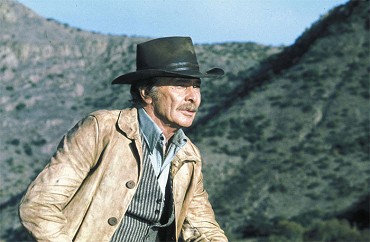
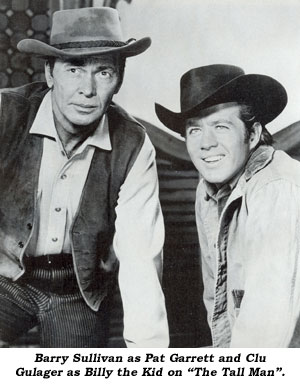
Jason Robards was "Governor Lew Wallace". Robard's had starred in Peckinpah's 1970 "The Ballad of Cable Hogue" opposite Stella Stevens.
R.G. Armstrong was "Deputy Sheriff Bob Orlinger".
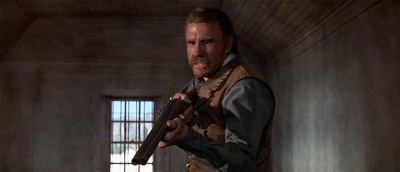
Below the real Bob Orlinger.
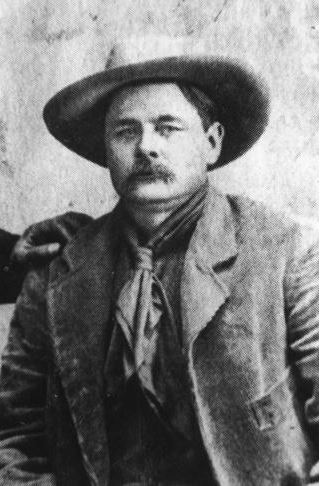
Charles Martin Smith, in the middle, was "Charlie Bowdre".
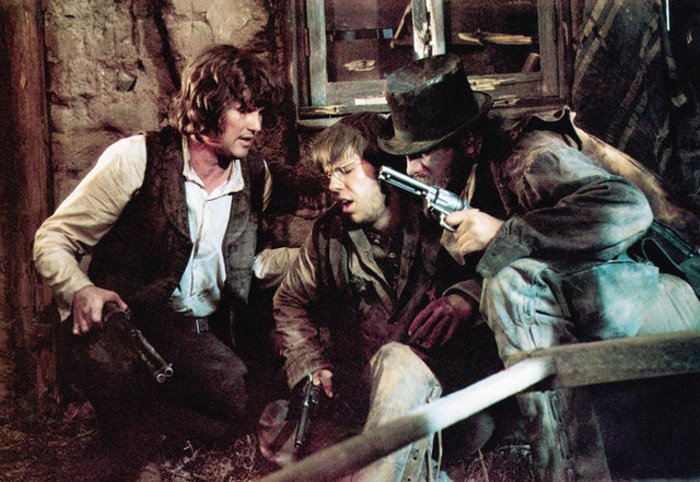
Below the real Charlie Bowdre.
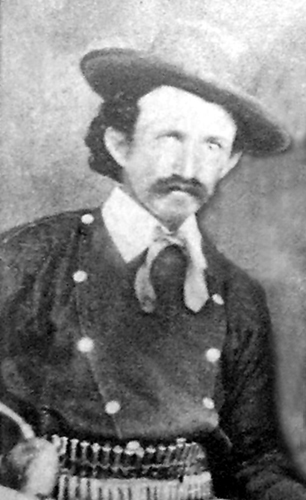
As I said the original screenplay writer Rudy Wurlitzer was"Tom O'Folliard".

Below the real Tom O'Folliard.

The Lincoln Country war is in the past and the film is set in the last year of the life of "Billy the Kid" 1881. The characters, except the 5 mentioned above, are all new to the audience.
However, one of Kristofferson's suggested actors was a singer and song writer Sam Peckinpah had never heard about. Who ended up writing the entire motion picture score. One song he wrote, became both the theme for the motion picture and a major hit "Knockin' on Heavens Door".
Bob Dylan would portray the fictional "Alias" and at times steal the scenes from the two leads.

Four other real life characters in the motion picture are:
Richard Jaeckel as Sheriff "Thomas Christopher 'Kip' McKinney".

John Beck, the actor and not the producer of the American version of 1962's "King Kong vs Godzilla", portrayed "John W. Poe".

Below the real Bob Orlinger.
Charles Martin Smith, in the middle, was "Charlie Bowdre".

Below the real Charlie Bowdre.

As I said the original screenplay writer Rudy Wurlitzer was"Tom O'Folliard".

Below the real Tom O'Folliard.

The Lincoln Country war is in the past and the film is set in the last year of the life of "Billy the Kid" 1881. The characters, except the 5 mentioned above, are all new to the audience.
However, one of Kristofferson's suggested actors was a singer and song writer Sam Peckinpah had never heard about. Who ended up writing the entire motion picture score. One song he wrote, became both the theme for the motion picture and a major hit "Knockin' on Heavens Door".
Bob Dylan would portray the fictional "Alias" and at times steal the scenes from the two leads.

Four other real life characters in the motion picture are:
Richard Jaeckel as Sheriff "Thomas Christopher 'Kip' McKinney".

John Beck, the actor and not the producer of the American version of 1962's "King Kong vs Godzilla", portrayed "John W. Poe".
Above John Beck and below "John Poe".
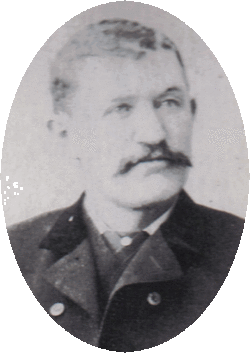
Jack Elam, portrayed the real life"Alamosa Bill Kermit". An outlaw alleged to have been associated with "Billy the Kid" and killed in April of 1888 in El Paso, Texas.

Mexican actress Aurora Clavel portrayed Pat Garrett's real life daughter "Ida".

Among the cast of familiar actors are:
Slim Pickens as "Sheriff Colin Baker".

Mexican actress Katy Jurado, 1952's "High Noon" and 1954's "Broken Lance", was Pickens' wife only identified as "Mrs. Baker".

Chill Wills, far left, was "Lemuel".
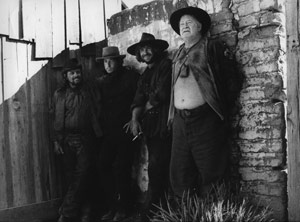
Gene Evans, director Sam Fueller's 1951 "Steel Helmet" and Eugene Lourie's 1959 "The Giant Behemoth", was "Mr. Horrell".

Don't blink, or you'll mess Harry Dean Stanton, Dub Taylor, Elisha Cook Jr., Bruce Dern and even Sam Peckinpah.
As I said the year is 1881 and William Bonney is 21 year old at the time. His friend Pat Garrett is 31 years old. The setting is Old Fort Sumner, New Mexico and "Billy the Kid" and his friends are passing the time shooting chickens. Riding into town comes Pat Garrett and Deputy Sheriff J.W. Bell. Over drinks "Garrett" informs "Bonney" that in five days he will be the new Sheriff and the powers that be want "Billy" out of town.
On the six day "Pat Garrett" and his deputies surround a farm house. Inside are "Billy" and "Charlie Bowdre". When the gunshots end. "Charlie" and several men on both sides are dead and "William H. Bonney" has been arrested for the murder of "Buckshot Roberts".
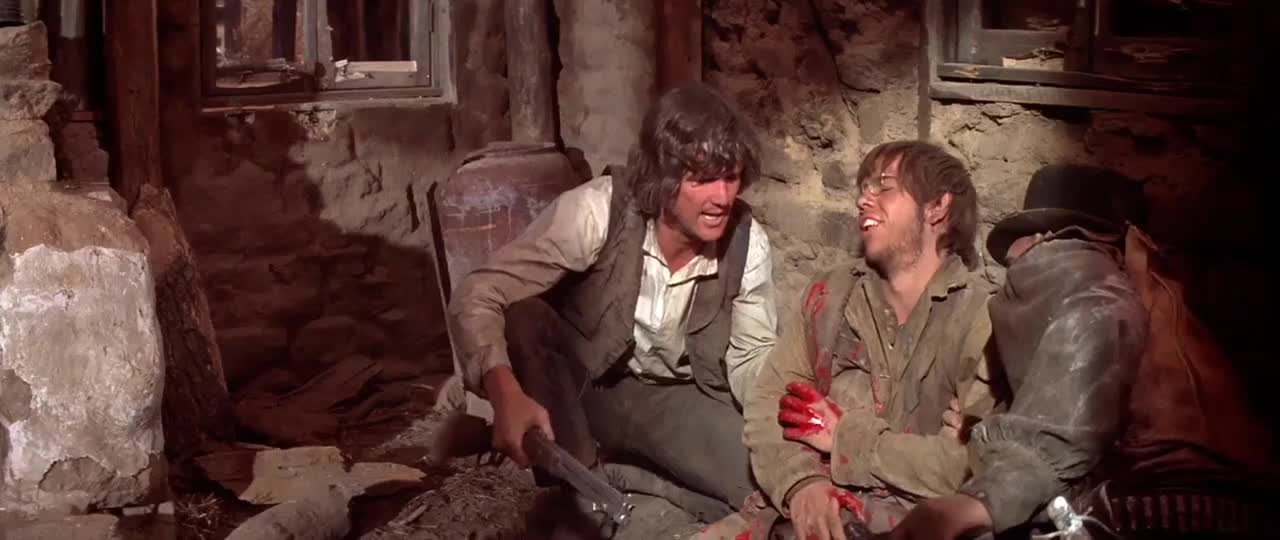

"Bob Orlinger" torments "Billy" with a shot gun he filled with sixteen dimes. "Pat" visits "Billy" and the two play cards. While "Orlinger" makes comments about the dimes and what he wants to do with them. At other times "James Bell" intervenes on "The Kid's" behalf and treats him well.


"Billy" escapes the Lincoln County Jail by first killing "James W. Bell". His grave headstone gives us the exact date of the escape.,
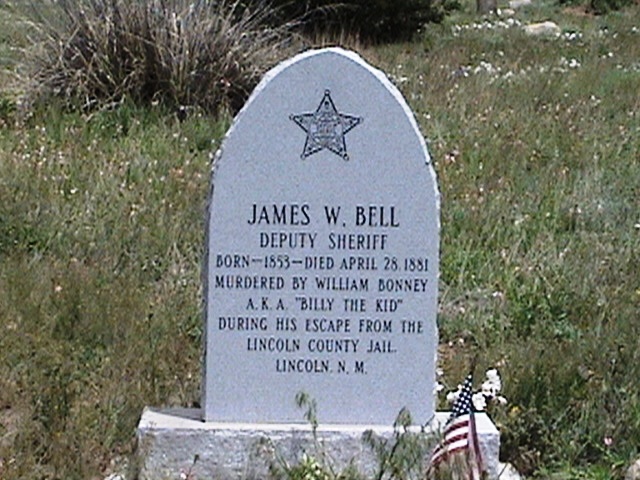
Next "Billy" takes the shotgun full of dimes and from a balcony shots "Bob Orlinger" dead saying:
Meanwhile,."Billy" returns to Old Fort Sumner to relax with his old gang. Inside he meets three strangers who want to kill him. They're killed with the help of a fourth with a knife. His name is "Alias" and he had witnessed the Lincoln County Jail escape.

"Pat Garrett" locates "Sheriff Colin Baker" for help getting some of "Billy's" gang. "Baker's" wife goes along and the three confront "Black Harris" and some others. "Harris" is killed, but "Sheriff Baker" is mortally wounded.
"Garrett" is now joined by glory seeking "John W. Poe" who works for the "Santa Fe Ring". The two meet "John Chisum" and are informed that "Billy" has been rustling his cattle again and killed some of his men. According to "Chisum": "The Kid" claims he's owed $500 in back pay and that's his motive for the rustling.Anticipating the arrival of "Garrett" in Old Fort Sumner "The Kid's" friend "Paco" takes his family and leaves for Mexico with "Billy" shortly following.
On his way to Mexico "Billy" stops at "Horrell's Trading Post". "Horrell" is an old friend and "The Kid" finds "Alamosa Bill" there. The two step outside for a gun duel and "Billy" kills "Alamosa". A little impossible as the real "Alamosa" was killed 7 years later in 1888.

Meanwhile, "Garrett" and "Poe" arrive in a small town and go into a saloon. "Garrett" tells "Poe", to get rid of him, to ride to Roswell and he'll join him in five to six days. After "Poe" leaves "Garrett" approaches some of "Billy's" friends.
Playing poker and drinking "Garrett" gets one named "Holly" drunk. When the other pulls a knife "Garrett" shoots him dead. He then approaches "Alias" and tells him to tell "Billy" they all had a drink together. "Garrett" leaves and rides to Roswell ahead of "Poe" to gather information and clues of the whereabouts of "The Kid".
"Garrett" is told that "Billy' has gone back to "Old Fort Sumner" and "Poe" arrives to confirm it.We now have the killing of "William H. Bonney".
"Garrrett", "Poe" and his posse arrive in Old Fort Sumner. After having sex with "Pete Maxwell's" daughter "Billy" goes to get something to eat. In the dark he notices two of "Garrett's" deputies, but they're afraid to shoot the outlaw. "Garrett" arrives and kills him. "Poe" starts to cut off "Billy's" trigger finger and is stopped by "Pat". The citizens of Old Fort Sumner find "Garrett" sitting on the front porch of the house with "The Kid's" body still within.

The film jumps to 28 years later to 1909, near Las Cruces, New Mexico. We see "Pat Garrett" riding with other members of "The Ring" into a ambush. Leading those in the ambush and death of "Pat Garrett" is "John W. Poe".
End of film.
Two problems with the murder of "Pat Garrett". The first is it occurred on February 29, 1908 and not in 1909. The second "Poe" was never considered as his murderer. As to what happened to "Poe" I quote the website "Legends of America":
https://www.legendsofamerica.com/law-johnpoe/
If my reader is interested in the actual "Assassination of Pat Garrett". This link will take you to the website "True West" and a very detailed account of the events leading up to it, the reasons and the aftermath.
https://truewestmagazine.com/the-assassination-of-pat-garrett/
YOUNG GUNS released August 12, 1988
YOUNG GUNS II released August 1, 1990
This is a two part "True Story" of "Billy the Kid" and stars a group of Hollywood "Young Guns" at the time and a few old pro's.


Both screenplays were written by blues musician John Fusco who co-produced the films. These were his second and third screenplays respectfully.
"Young Guns" was co-produced and directed by American Christopher Cain. He did neither for the sequel. At the time this was Cain's eighth motion picture as a director. "Young Guns II" was directed by New Zealander Geoff Murphy. This was his eighth motion picture and Murphy had a New Zealand television mini-series to his credit also.
The two films have a large cast of actors portraying real people involved with "Billy the Kid's" story. I will start with those people already familiar to my reader and who portrayed them in these features.Unless I mention specially just one of the two movies. My reader will know the person is in both motion pictures.
Emilio Estevez was "William H. Booney". In 1984 he had co-starred in "Repo Man", 1985 saw him in John Hughes "The Breakfast Club" and additionally in "St Elmo's Fire". In 1986 it was "Maximum Overdrive".

"Pat Garrett" was portrayed by two different actors.
Patrick Wayne was "Garrett" in "Young Guns". He had appeared as a small boy in a few of his father's films and played a cavalry lieutenant in 1956's "The Searchers". Wayne was "Captain James Butler Bonham" in 1960's "The Alamo", was "Sinbad" in Ray Harryhausen's 1977 "Sinbad and the Eye of the Tiger" and appeared in other of his father films and on television.

William Petersen was "Pat Garrett in "Young Guns II". Petersen is best known as "Gil Grissom" on televisions original "CSI". Many believe Jody Foster portrayed the first FBI agent to deal with "Hannibal Lechter" in the 1991 movie "Silence of the Lambs". However, five years prior, William Petersen played former FBI Profiler "Will Graham" tracking down "Hannibal Lechter" portrayed by Brian Cox, not Anthony Hopkins, in the original 1986 motion picture "Manhunter". The was based upon the Thomas Harris novel "Red Dragon".

British actor Terrence Stamp was "John Tunstall" in "Young Guns". Stamp became internationally known for both 1962's "Billy Budd" and 1965's "The Collector". in 1978 and 1979 audiences saw him as "General Zod" in "Superman" and "Superman II".

Jack Palance was "Lawrence Murphy" in "Young Guns". In 1953 Palance was the emotionless gunfighter in "Shane". The same year he was both "Jack the Ripper" and "Attila the Hun". He appeared in several Italian made World War 2 motion pictures and was the future "Joker's" boss in Tim Burton's 1989 "Batman".

Casey Siemaszko was "Charlies Bowdre" in "Young Guns". Prior to this film Siemasko was in 1985's "Back to the Future", 1986's "Stand by Me" and 1988's "Biloxi Blues".

Terry O'Quinn portrayed "Alexander McSween" in "Young Guns". O'Quinn was in 1980's "Heavens Gate", 1984's "Mrs Soffel" and 1985's "Silver Bullet". Sharon Thomas portrayed "Susan McSween" in "Young Guns". She had been mostly on television prior to this picture. Except in the roles of a waitress in both 1984's "The Stone Boy" and "Star Trek III: The Search for Spock".

Jack Elam, portrayed the real life"Alamosa Bill Kermit". An outlaw alleged to have been associated with "Billy the Kid" and killed in April of 1888 in El Paso, Texas.

Mexican actress Aurora Clavel portrayed Pat Garrett's real life daughter "Ida".

Among the cast of familiar actors are:
Slim Pickens as "Sheriff Colin Baker".

Mexican actress Katy Jurado, 1952's "High Noon" and 1954's "Broken Lance", was Pickens' wife only identified as "Mrs. Baker".

Chill Wills, far left, was "Lemuel".

Gene Evans, director Sam Fueller's 1951 "Steel Helmet" and Eugene Lourie's 1959 "The Giant Behemoth", was "Mr. Horrell".

Don't blink, or you'll mess Harry Dean Stanton, Dub Taylor, Elisha Cook Jr., Bruce Dern and even Sam Peckinpah.
As I said the year is 1881 and William Bonney is 21 year old at the time. His friend Pat Garrett is 31 years old. The setting is Old Fort Sumner, New Mexico and "Billy the Kid" and his friends are passing the time shooting chickens. Riding into town comes Pat Garrett and Deputy Sheriff J.W. Bell. Over drinks "Garrett" informs "Bonney" that in five days he will be the new Sheriff and the powers that be want "Billy" out of town.
On the six day "Pat Garrett" and his deputies surround a farm house. Inside are "Billy" and "Charlie Bowdre". When the gunshots end. "Charlie" and several men on both sides are dead and "William H. Bonney" has been arrested for the murder of "Buckshot Roberts".


"Bob Orlinger" torments "Billy" with a shot gun he filled with sixteen dimes. "Pat" visits "Billy" and the two play cards. While "Orlinger" makes comments about the dimes and what he wants to do with them. At other times "James Bell" intervenes on "The Kid's" behalf and treats him well.


"Billy" escapes the Lincoln County Jail by first killing "James W. Bell". His grave headstone gives us the exact date of the escape.,

Next "Billy" takes the shotgun full of dimes and from a balcony shots "Bob Orlinger" dead saying:
KEEP THE CHANGE BOB!"Garrett" returns to Lincoln and hires a new deputy "Alamosa Bill Kermit". "Pat" leaves "Alamosa" in Lincoln and rides to Santa Fe to meet with Governor "Lew Wallace". "Wallace" introduces him to some powerful men referred as the "Santa Fe Ring". The "Ring" offers him $1,000 to bring "Billy the Kid" in and gives him half as upfront money. "Garrett" tells him he'll do it, IF they don't start another Lincoln County War.
Meanwhile,."Billy" returns to Old Fort Sumner to relax with his old gang. Inside he meets three strangers who want to kill him. They're killed with the help of a fourth with a knife. His name is "Alias" and he had witnessed the Lincoln County Jail escape.

"Pat Garrett" locates "Sheriff Colin Baker" for help getting some of "Billy's" gang. "Baker's" wife goes along and the three confront "Black Harris" and some others. "Harris" is killed, but "Sheriff Baker" is mortally wounded.
"Garrett" is now joined by glory seeking "John W. Poe" who works for the "Santa Fe Ring". The two meet "John Chisum" and are informed that "Billy" has been rustling his cattle again and killed some of his men. According to "Chisum": "The Kid" claims he's owed $500 in back pay and that's his motive for the rustling.Anticipating the arrival of "Garrett" in Old Fort Sumner "The Kid's" friend "Paco" takes his family and leaves for Mexico with "Billy" shortly following.
On his way to Mexico "Billy" stops at "Horrell's Trading Post". "Horrell" is an old friend and "The Kid" finds "Alamosa Bill" there. The two step outside for a gun duel and "Billy" kills "Alamosa". A little impossible as the real "Alamosa" was killed 7 years later in 1888.

Meanwhile, "Garrett" and "Poe" arrive in a small town and go into a saloon. "Garrett" tells "Poe", to get rid of him, to ride to Roswell and he'll join him in five to six days. After "Poe" leaves "Garrett" approaches some of "Billy's" friends.
Playing poker and drinking "Garrett" gets one named "Holly" drunk. When the other pulls a knife "Garrett" shoots him dead. He then approaches "Alias" and tells him to tell "Billy" they all had a drink together. "Garrett" leaves and rides to Roswell ahead of "Poe" to gather information and clues of the whereabouts of "The Kid".
"Garrett" is told that "Billy' has gone back to "Old Fort Sumner" and "Poe" arrives to confirm it.We now have the killing of "William H. Bonney".
"Garrrett", "Poe" and his posse arrive in Old Fort Sumner. After having sex with "Pete Maxwell's" daughter "Billy" goes to get something to eat. In the dark he notices two of "Garrett's" deputies, but they're afraid to shoot the outlaw. "Garrett" arrives and kills him. "Poe" starts to cut off "Billy's" trigger finger and is stopped by "Pat". The citizens of Old Fort Sumner find "Garrett" sitting on the front porch of the house with "The Kid's" body still within.

The film jumps to 28 years later to 1909, near Las Cruces, New Mexico. We see "Pat Garrett" riding with other members of "The Ring" into a ambush. Leading those in the ambush and death of "Pat Garrett" is "John W. Poe".
End of film.
Two problems with the murder of "Pat Garrett". The first is it occurred on February 29, 1908 and not in 1909. The second "Poe" was never considered as his murderer. As to what happened to "Poe" I quote the website "Legends of America":
https://www.legendsofamerica.com/law-johnpoe/
In late 1882, Pat Garrett decided not to run for sheriff again, but rather than backing his deputy, John Poe, who was running, he instead backed a man named James Dolan, who had been one of the main perpetrators of the Lincoln County War. This would seemingly indicated that there was some friction between the two lawmen. In any event, Poe won the election and served as sheriff of Lincoln County until December 31, 1885. After resigning as a lawman, he moved to Roswell, where he operated a mercantile business and then in 1890 founded the Bank of Roswell and ten years later, the Citizens Bank of Roswell in 1900. He wrote several articles for newspapers and a book about the death of Billy the Kid. Poe died at Roswell, New Mexico on July 22, 1923.
If my reader is interested in the actual "Assassination of Pat Garrett". This link will take you to the website "True West" and a very detailed account of the events leading up to it, the reasons and the aftermath.
https://truewestmagazine.com/the-assassination-of-pat-garrett/
YOUNG GUNS released August 12, 1988
YOUNG GUNS II released August 1, 1990
This is a two part "True Story" of "Billy the Kid" and stars a group of Hollywood "Young Guns" at the time and a few old pro's.


Both screenplays were written by blues musician John Fusco who co-produced the films. These were his second and third screenplays respectfully.
"Young Guns" was co-produced and directed by American Christopher Cain. He did neither for the sequel. At the time this was Cain's eighth motion picture as a director. "Young Guns II" was directed by New Zealander Geoff Murphy. This was his eighth motion picture and Murphy had a New Zealand television mini-series to his credit also.
The two films have a large cast of actors portraying real people involved with "Billy the Kid's" story. I will start with those people already familiar to my reader and who portrayed them in these features.Unless I mention specially just one of the two movies. My reader will know the person is in both motion pictures.
Emilio Estevez was "William H. Booney". In 1984 he had co-starred in "Repo Man", 1985 saw him in John Hughes "The Breakfast Club" and additionally in "St Elmo's Fire". In 1986 it was "Maximum Overdrive".

"Pat Garrett" was portrayed by two different actors.
Patrick Wayne was "Garrett" in "Young Guns". He had appeared as a small boy in a few of his father's films and played a cavalry lieutenant in 1956's "The Searchers". Wayne was "Captain James Butler Bonham" in 1960's "The Alamo", was "Sinbad" in Ray Harryhausen's 1977 "Sinbad and the Eye of the Tiger" and appeared in other of his father films and on television.

William Petersen was "Pat Garrett in "Young Guns II". Petersen is best known as "Gil Grissom" on televisions original "CSI". Many believe Jody Foster portrayed the first FBI agent to deal with "Hannibal Lechter" in the 1991 movie "Silence of the Lambs". However, five years prior, William Petersen played former FBI Profiler "Will Graham" tracking down "Hannibal Lechter" portrayed by Brian Cox, not Anthony Hopkins, in the original 1986 motion picture "Manhunter". The was based upon the Thomas Harris novel "Red Dragon".

British actor Terrence Stamp was "John Tunstall" in "Young Guns". Stamp became internationally known for both 1962's "Billy Budd" and 1965's "The Collector". in 1978 and 1979 audiences saw him as "General Zod" in "Superman" and "Superman II".

Jack Palance was "Lawrence Murphy" in "Young Guns". In 1953 Palance was the emotionless gunfighter in "Shane". The same year he was both "Jack the Ripper" and "Attila the Hun". He appeared in several Italian made World War 2 motion pictures and was the future "Joker's" boss in Tim Burton's 1989 "Batman".

Casey Siemaszko was "Charlies Bowdre" in "Young Guns". Prior to this film Siemasko was in 1985's "Back to the Future", 1986's "Stand by Me" and 1988's "Biloxi Blues".

Terry O'Quinn portrayed "Alexander McSween" in "Young Guns". O'Quinn was in 1980's "Heavens Gate", 1984's "Mrs Soffel" and 1985's "Silver Bullet". Sharon Thomas portrayed "Susan McSween" in "Young Guns". She had been mostly on television prior to this picture. Except in the roles of a waitress in both 1984's "The Stone Boy" and "Star Trek III: The Search for Spock".

James Coburn portrayed "John Chisum" in "Young Gun II"..

Balthazar Getty was "Tom O'Folliard" in "Young Guns II". Getty was in 1990's "Lord of the Flies" before this film which was his second,
Viggo Mortensen was "John W. Poe" in "Young Guns II". Mortensen is best known for Peter Jackson's "The Lord of the Rings Trilogy" as "Aragorn".

Leon Rippy was "Robert 'Bob' Orlinger" in "Young Guns II". Prior to this film Rippy was in 1984's "Firestarter", 1985's "The Color Purple" and 1986's "King Kong Lives".

I couldn't locate any stills of the actors, but Tom Kurtlander was "J.W. Bell" and Scott Wilson was "Governor Lew Wallace" in "Young Guns II".
Here are some of the other real people that were not seen in any of the previous motion pictures about "Billy the Kid".
Kiefer Sutherland was "Josiah Gordon 'Doc' Scurlock". Sutherland was in 1986's "Stand By Me", 1987's "The Lost Boys" before these two feature films.

Leon Rippy was "Robert 'Bob' Orlinger" in "Young Guns II". Prior to this film Rippy was in 1984's "Firestarter", 1985's "The Color Purple" and 1986's "King Kong Lives".
I couldn't locate any stills of the actors, but Tom Kurtlander was "J.W. Bell" and Scott Wilson was "Governor Lew Wallace" in "Young Guns II".
Here are some of the other real people that were not seen in any of the previous motion pictures about "Billy the Kid".
Kiefer Sutherland was "Josiah Gordon 'Doc' Scurlock". Sutherland was in 1986's "Stand By Me", 1987's "The Lost Boys" before these two feature films.
Below the real "Josiah Gordon 'Doc' Scurlock".

Lou Diamond Phillips was "Jose Chavez y Chavez". Before these films Phillips was best known for portraying "Ritchie Valens" in 1987's "La Bamba".

Below the real "Jose Chavez y Chavez".

Charlie Sheen was "Richard 'Dick" Brewer" in "Young Guns". Sheen was in 1973's "Badlands", the original 1984 "Red Dawn", in 1986 he was in "Ferris Bueller's Day Off", "The Wrath" and "Platoon".
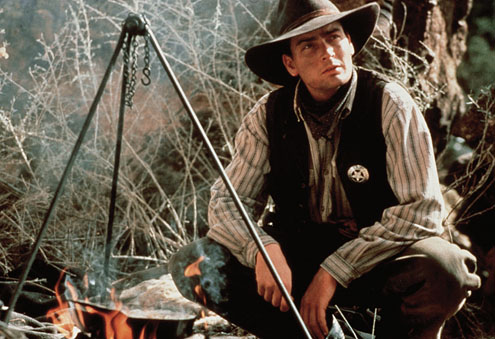
Below the real "Richard 'Dick' Brewer".

Christian Slater was "Arkansas' Dave Rudabaugh" in "Young Guns II". Prior to this movie Slater was working mostly on television, but did 1985's "The Legend of Billie Jean" and 1986's "The Name of the Rose' starring Sean Connery.

Lou Diamond Phillips was "Jose Chavez y Chavez". Before these films Phillips was best known for portraying "Ritchie Valens" in 1987's "La Bamba".

Below the real "Jose Chavez y Chavez".

Charlie Sheen was "Richard 'Dick" Brewer" in "Young Guns". Sheen was in 1973's "Badlands", the original 1984 "Red Dawn", in 1986 he was in "Ferris Bueller's Day Off", "The Wrath" and "Platoon".

Below the real "Richard 'Dick' Brewer".

Christian Slater was "Arkansas' Dave Rudabaugh" in "Young Guns II". Prior to this movie Slater was working mostly on television, but did 1985's "The Legend of Billie Jean" and 1986's "The Name of the Rose' starring Sean Connery.
The real "Arkansas Dave Rudabaugh" aka: "Dirty Dave Rudabaugh".
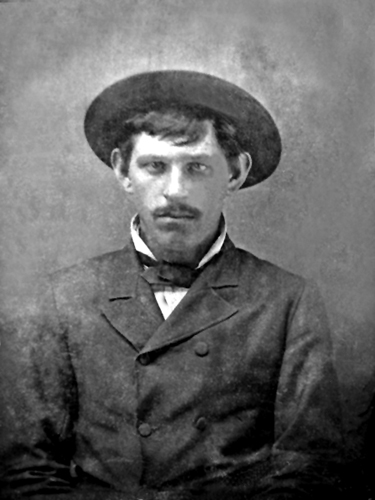
Brain Keith was "Buckshot Roberts" in "Young Guns". Among Keith's films was Walt Disney's true story of the first mapping the Colorado River "Ten Who Dares" in 1960 and the original "The Parent Trap" in 1961. Keith was the star of the short lived Sam Peckinpah 1960 Western television series "The Westerner". Another role was that of President Theodore Roosevelt in the Sean Connery 1975 "The Wind and the Lion".

Below the real "Buckshot Roberts'.

Alan Ruck was "Jim French" aka: "Big Jim French" aka: "Frenchy French" in "Young Guns II". Ruck was in 1983's "Bad Boys" starring Sean Penn and 1986's "Ferris Bueller's Day Off" prior to this picture.

Below "Frenchy French".

The plot of "Young Guns".

Brain Keith was "Buckshot Roberts" in "Young Guns". Among Keith's films was Walt Disney's true story of the first mapping the Colorado River "Ten Who Dares" in 1960 and the original "The Parent Trap" in 1961. Keith was the star of the short lived Sam Peckinpah 1960 Western television series "The Westerner". Another role was that of President Theodore Roosevelt in the Sean Connery 1975 "The Wind and the Lion".

Below the real "Buckshot Roberts'.

Alan Ruck was "Jim French" aka: "Big Jim French" aka: "Frenchy French" in "Young Guns II". Ruck was in 1983's "Bad Boys" starring Sean Penn and 1986's "Ferris Bueller's Day Off" prior to this picture.

Below "Frenchy French".

The plot of "Young Guns".
The film starts out with "John Tunstall" recruiting young gun hands to work his ranch. He is at odds with another rancher "Lawrence Murphy". "Tunstall" is murdered and "Billy", "Doc Scurlock", "Jose Chavez y Chavez", "Dick Brewer", "Dirty Steven Stephens" and "Charlie Bowdre" consult "Tunstall's" lawyer and friend "Alexander McSween". "McSween" manages to get them deputized and issued warrants.
The group calling themselves "The Regulators" go after "Murphy's" men. "Dick Brewer" is appointed leader, but "Billy" is opposed to him. Not wanting to wait for justice "Billy" guns down some unarmed "Murphy" men and killing a new "Regulator J. McCloskey" believing, correctly, he is working for ""Murphy". The group learns from a newspaper that they have been stripped of their badges and a picture of "Dick" is confused by the paper as the newly labeled "Billy the Kid".
While the local law starts to hunt "Billy Bonney" and his gang. The "Young Guns" debate if they should finish serving their warrants, or go on the run. However, "Buckshot Roberts", whose name is on one of the outstanding warrants, tracks them down and holes himself up in a house to lure the group to him. A gunfight takes place and "Dick" is killed, but the others leave. The real gunfight created a Western Legend in "Buckshot" and is a very good yarn that can be read on the website "Legends of America" at:
https://www.legendsofamerica.com/we-buckshotroberts/
As a result of "Dick Brewer's" death "Billy Bonney" becomes the new leader and the gang is being pursued by the United States Army. The gang is able to allude the army and in Mexico "Charlie Bowdre" gets married and "Billy" again meets gunfighter "Pat Garrett". "Garrett" tells him he heard that "Murphy" plans to kill "Alex McSween". The young outlaws had back to Lincoln to save "Alex".
"Murphy's Men" are led by, another real person, George Peppin" a friend of "John Doland", and surround "McSween's" house. A gunfight breaks out and that night a cease fire is declared, but the army arrives.
Everyone breaks out of the house attempting to escape on foot, but "Charlie" challenges Bounty Hunter "John Kinney" to a one on one gunfight. They end up killing each other.
"Chavez y Chavez" jumps the army barricade and gets horses to "The Regulators". "Doc" and some of the others escape to cheers from "Alex McSween" who is shot to death by the army's Gatling gun. However, "Steve" still needs a horse and "Chavez" attempts to get him one, but is wounded and falls to the ground. "Steve" helps him to his horse and he rides off as the unarmed "Steve" is shot dead.
As all of this is happening "Murphy" is suddenly surprised to find "Billy" in front of him. "The Kid" shoots "Murphy" between the eyes and rides off.
Voice over starts from "Doc" telling the viewer what happened afterwards. "Susan McSween" went to Washington D.C. and started a Congressional Investigation into the "Lincoln County War" and became a successful large rancher, "Chavez y Chavez" took work on a California farm, "Doc" moved east to New York and married his girlfriend and "Billy" was killed by "Sheriff Pat Garrett". He was buried next to the grave of "Charlie Bowdre". One night someone came to that grave and scratched the word "Pals" upon the headstone.
End of first film.,
The actual "Doc Scurlock" went to Texas and became a respectable citizen. He even ran the mail station in Potter County and on July 25, 1929 the 80 year old died of a heart attack.
In 1894 "Chavez y Chavez" was involved in a killing spree still in New Mexico, which he never left, but the new Governor changed his death sentence to life in prison. During a prison riot, January 11, 1909, he helped the police. Governor George Curry issued "Chavez y Chavez" a pardon. He died of natural causes at his home in 1924.
"Susan McSween" struggled after her husband's death and the "Estate of John Tunstall", from England, helped her financially for awhile. She never went to Washington,D.C. and would remarry and then divorce. "Susan McSween" had acquired a small cattle ranch and in 1902 sold her holdings. She moved to a small house near White Oaks, New Mexico and over time spent what little money she had. On January 3, 1931 she died impoverished of pneumonia.
Plot of "Young Guns II".
The film opens in 1950 with "Bushy Bill Roberts", Emilio Estevez below, seeing an attorney and asking for his pardon he was promised 70 years ago. He tells the lawyer he is really "Billy the Kid" and this story starts.

"Billy" is now part of a new outlaw gang with "Arkansas Dave Rudabaugh" and "Pat Garrett". The New Mexico Governor has issued warrants for the arrest of "Doc Scurlock" and "Chavez y Chavez". They are seen being dragged into Lincoln to await their hanging and the arrest of "Billy".
"Billy" goes to see "Governor Lew Wallace" who promises him a pardon, if he testifies against the "Murphy-Dolan" faction in the "Lincoln County War". "Billy" discovers he was tricked into giving himself up and escapes jail. He finds "Rudabaugh" and "Garrett" and the three get the other two out of jail and head for Mexico. However, "Pat". "Garrett" decides to go straight and opens a boarding house.
On their way to Mexico "Billy", Rudabaugh", who wants to lead the gang, "Doc" and "Chavez y Chavez" pick up a farmer, "Henry William French" and a 14 year old boy named "Tom O'Folliard". The actual age of the outlaw as new gang members.
Meanwhile, "John Chisum" and "Governor Lew Wallace" approach "Pat Garrett" to become the new Lincoln County Sheriff and offer him $1,000 to use in whatever means to get "Billy the Kid".
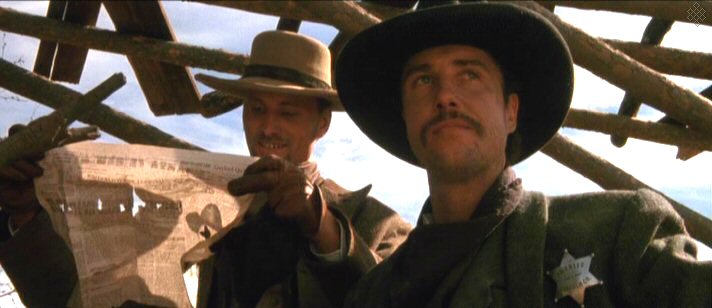
The gang now comes to the town of White Oaks and goes to the local bordello run by an old friend "Jane Greathouse", but a lynch mob shows up to hang the outlaws. "Sheriff "Carlisle" attempts to negotiate a deal, but instead is accidentally killed by the lynch mob. "Pat Garrett" and his posse show up after "Billy's" gang has left and because "Greathouse" won't cooperate with him. He orders the bordello burnt to the ground and leaves.
The gang is ambushed and "Doc" stays behind to allow the rest to escape and is killed. "Billy" is captured by "Pat" and sentenced to be hanged. He is visited in jail by "Jane Greathouse" wanting to get even with "Garrett". She tells him there will be a pistol in the outhouse. He uses the pistol to kill two guards and escapes to Old Fort Sumner.
When "Billy" gets to Old Fort Sumner. He finds that "Dave" has left the group for Mexico and "Chavez y Chavez" is dying from a gunshot wound. During the night "Pat Garrett" finds "Billy". Who asks "Pat" to let him go to Mexico and that he can say he killed him."Garrett" replies that if he did what "Bonney" is asking. "Billy" could not resist returning to the United States and getting "Pat" killed as a liar. "The Kid" turns and starts to walk away. That action would force "Pat" to shoot him in the back.
Quick cut to the next morning and there's a fake burial/ While a man is seen leading "Pat Garrett's" horse away with the implication it's "Billy the Kid". Switch to "Bushy Roberts" talking to the lawyer who believes he is "Billy the Kid" and agrees to help me.
The movie ends telling the audience that "Arkansas Dave Rudabaugh" was beheaded in Mexico. Which is correct, but leaves out what happened between this story and that event. That he was part of the "Clamton Gang" in their war against the "Earps" in Arizona. That it is believed "Rudabaugh" may have been involved with the murder of "Morgan Earp" and the attempted murder of "Virgil Earp". He is also believed to have been part of the gunfight against "Wyatt" and "Doc Holiday" in Iron Springs, Arizona, in which "Curly Billy Brocus" was killed.
GORE VIDAL'S BILLY THE KID released May 1989
This was a made for television motion picture. Western historians praised the film for its historical accuracy. The screenplay was by Gore Vidal the writer of "The Left Handed Gun". In pre-production Vidal had complained the studio ruined his original screenplay and now wanted to rewrite a more accurate rendition of the events.

Val Kilmer was praised for his portrayal of "William Bonney". This was his 7th film which included 1984's "Top Secret", 1985's "Real Genius" and 1986's "Top Gun".
Duncan Regehr was "Pat Garrett". Regehr was a television actor and prior to this film some of his work included the 1982 mini-series "The Blue and the Grey", the 1984 mini-series "The Last Days of Pompeii" and the original 1985 mini-series "V".

The problem for me was finding a description of the movie and a detailed cast list. So I am giving my reader a link to an excellent Western website "Jack Arnold's West":
http://jeffarnoldblog.blogspot.com/2015/03/gore-vidals-billy-kid-tnt-1989.html
REQUIEM FOR BILLY THE KID released May 20, 2006
"Requiem for Billy the Kid" was by French Film maker Anne Feinsiber. Who traveled from France to film a documentary on the life of "William H. Bonney". It contains interviews with different Western historians and images from "Pat Garrett and Billy the Kid"
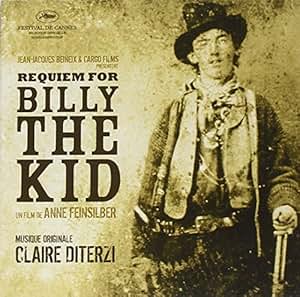
THE KID released March 8, 2019

In this film both "Billy the Kid" and "Pat Garrett" are secondary figures that keep crossing the main character a young boy named "Rio Cutter" portrayed by Jake Schur. The actual "KID" of the title.
"Rio" is crossing the country to protect his sister "Sara Cutter", Lelia George, from their evil "Uncle Grant Cutter", Chris Pratt. As "Rio" attempts to protect his sister the last year of "William H. Bonney" unfolds around him and in the end he witnesses the death of "Billy the Kid".
Arielle Bernstein on Rodger Ebbert's website wrote in her review:
The Kid," directed by Vincent D’Onofrio, is, in some ways, a modern spin on an old story, one that has been explored in Hollywood many times before. Based on the real-life tale of the showdown between the famous young outlaw, Billy the Kid, and his arch nemesis, Sheriff Pat Garrett, D’Onofrio’s film transforms many of the classical western tropes into a meditation on the lingering after-effects of domestic violence. The story centers on the coming-of-age journey of Rio, a 14-year-old who shoots his abusive father in an unsuccessful attempt to save his mother from being beaten to death. When Rio and his sister Sara attempt to run, they are accosted by their cruel Uncle Grant, played by Chris Pratt, who threatens to take them both. After playing a series of chipper characters, Pratt makes a believable villain.https://www.rogerebert.com/reviews/the-kid-2019
Will there be more motion pictures about "Billy the Kid"? Of course as his mythic life still fascinates.







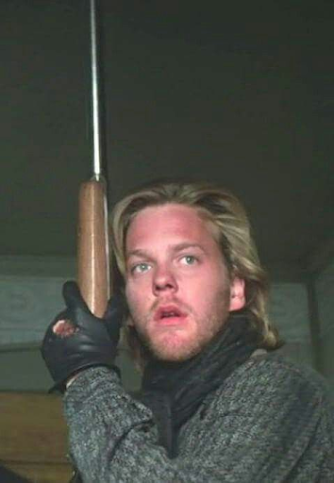



No comments:
Post a Comment